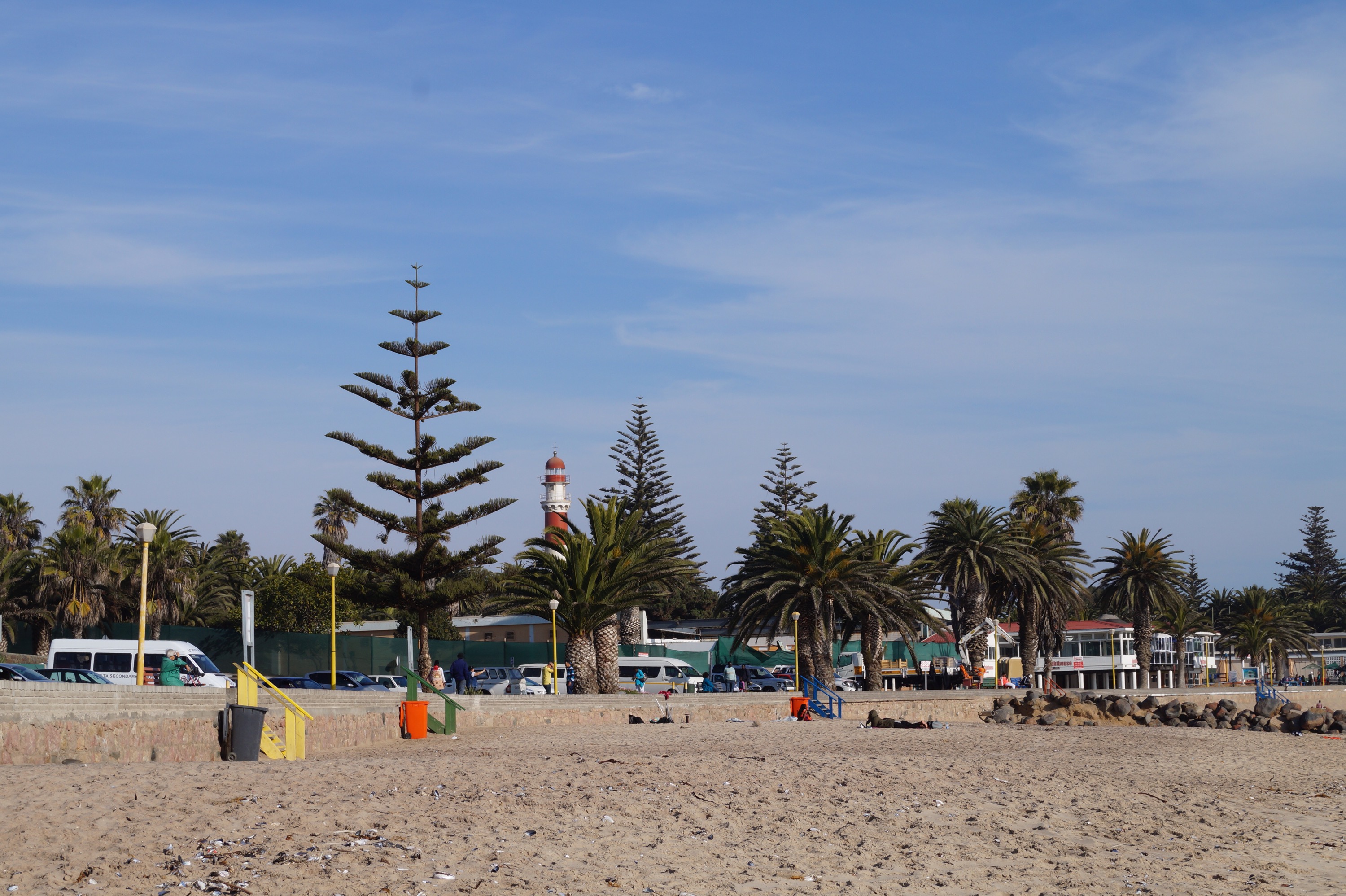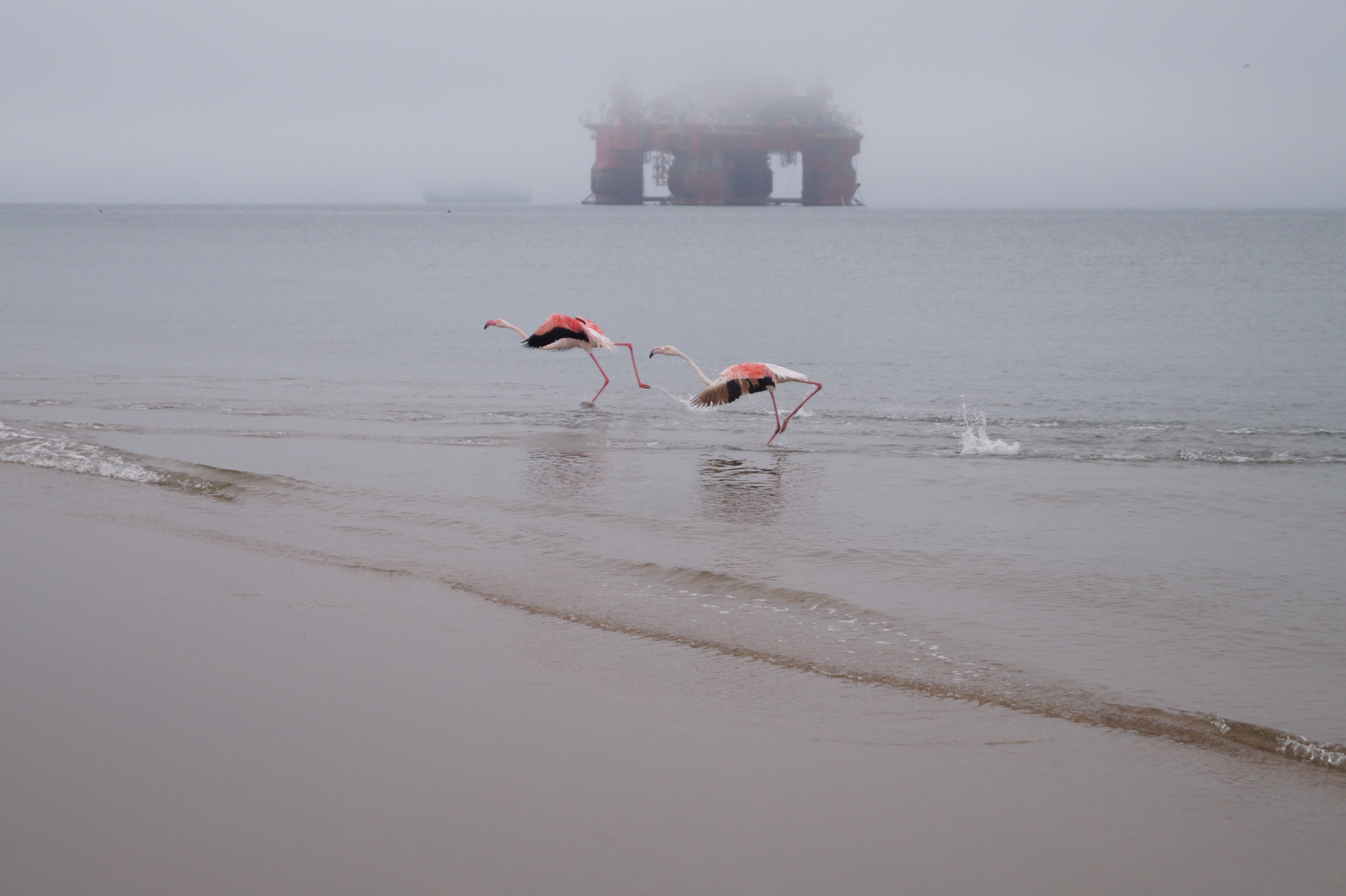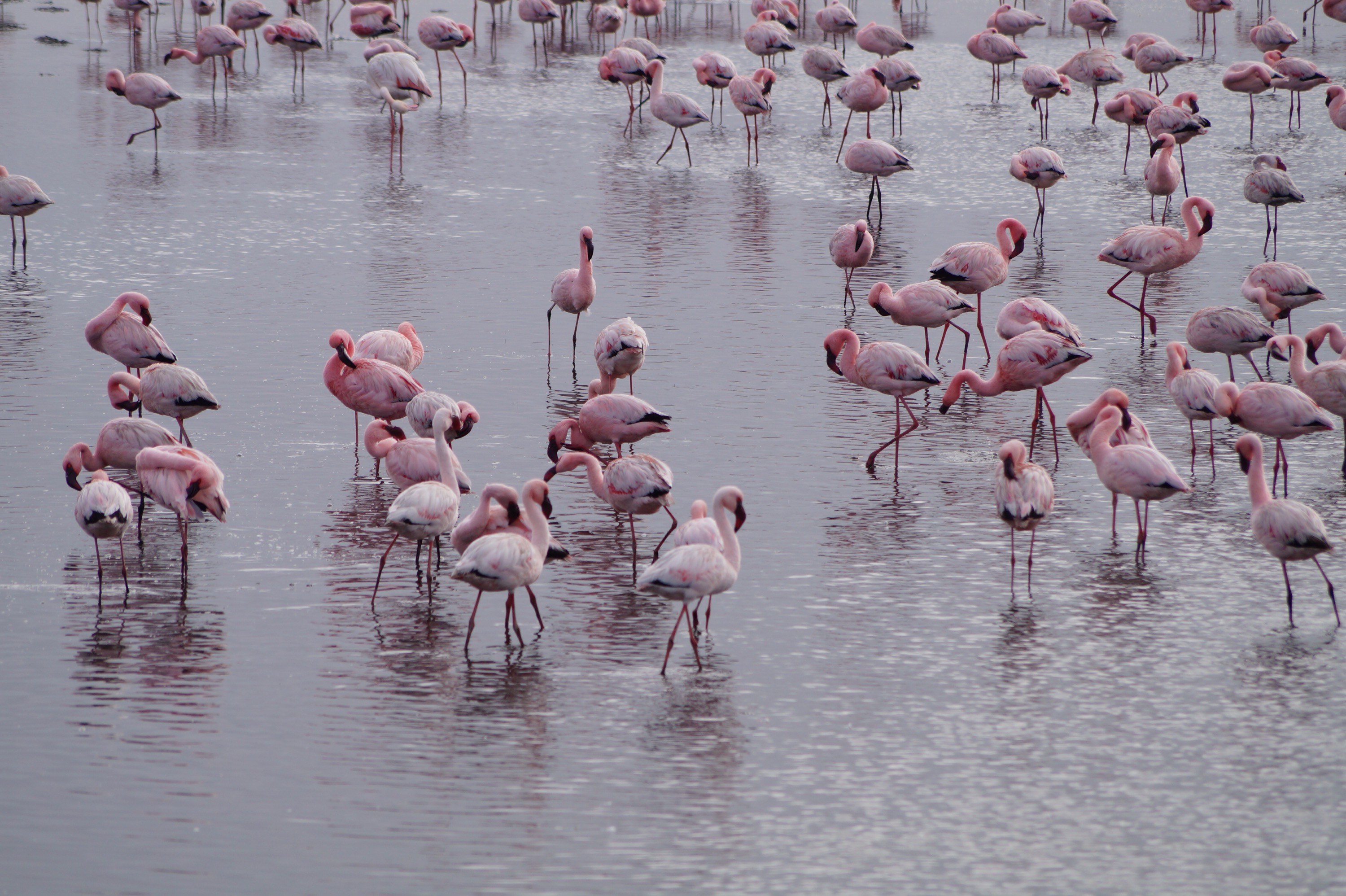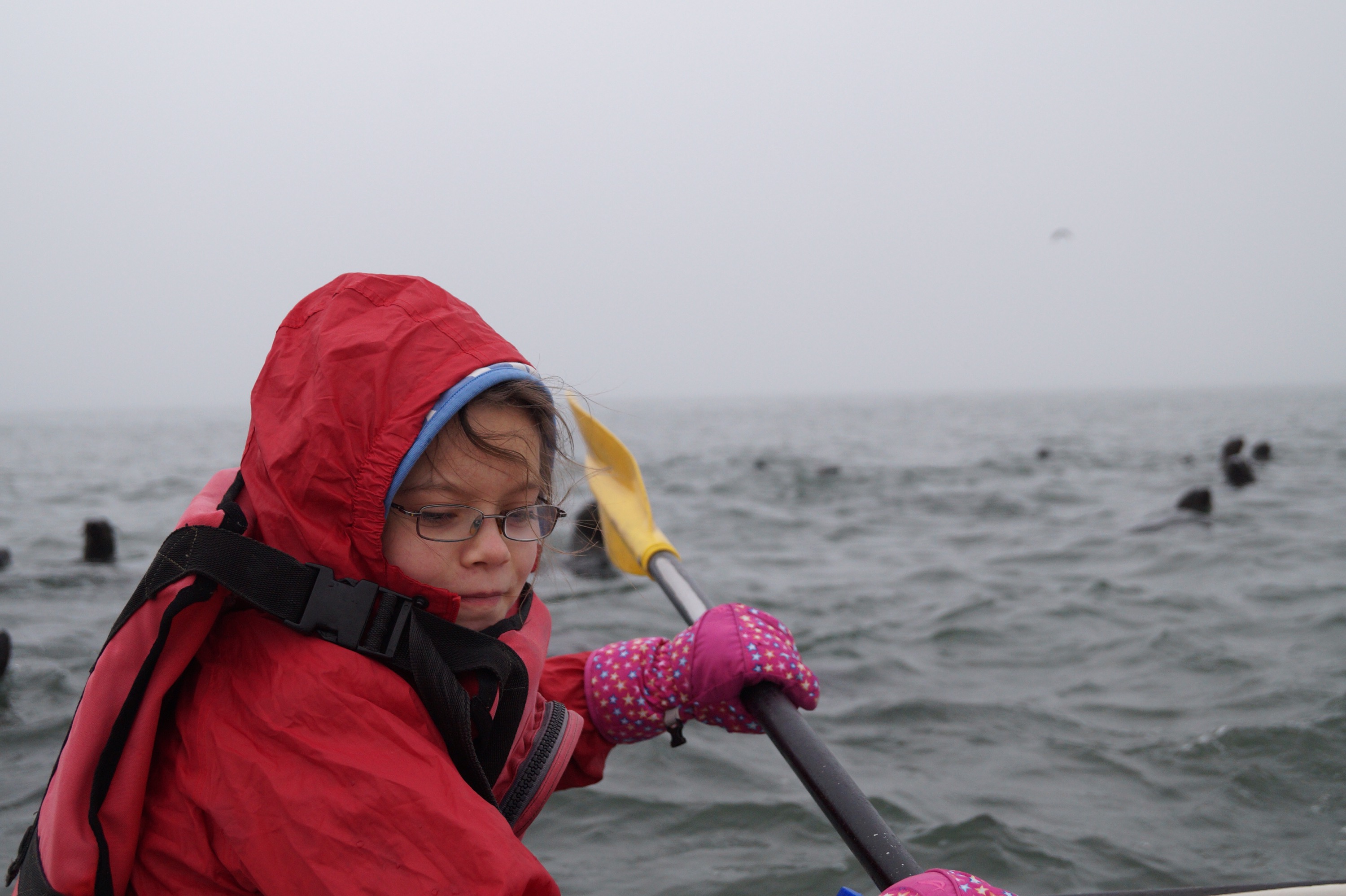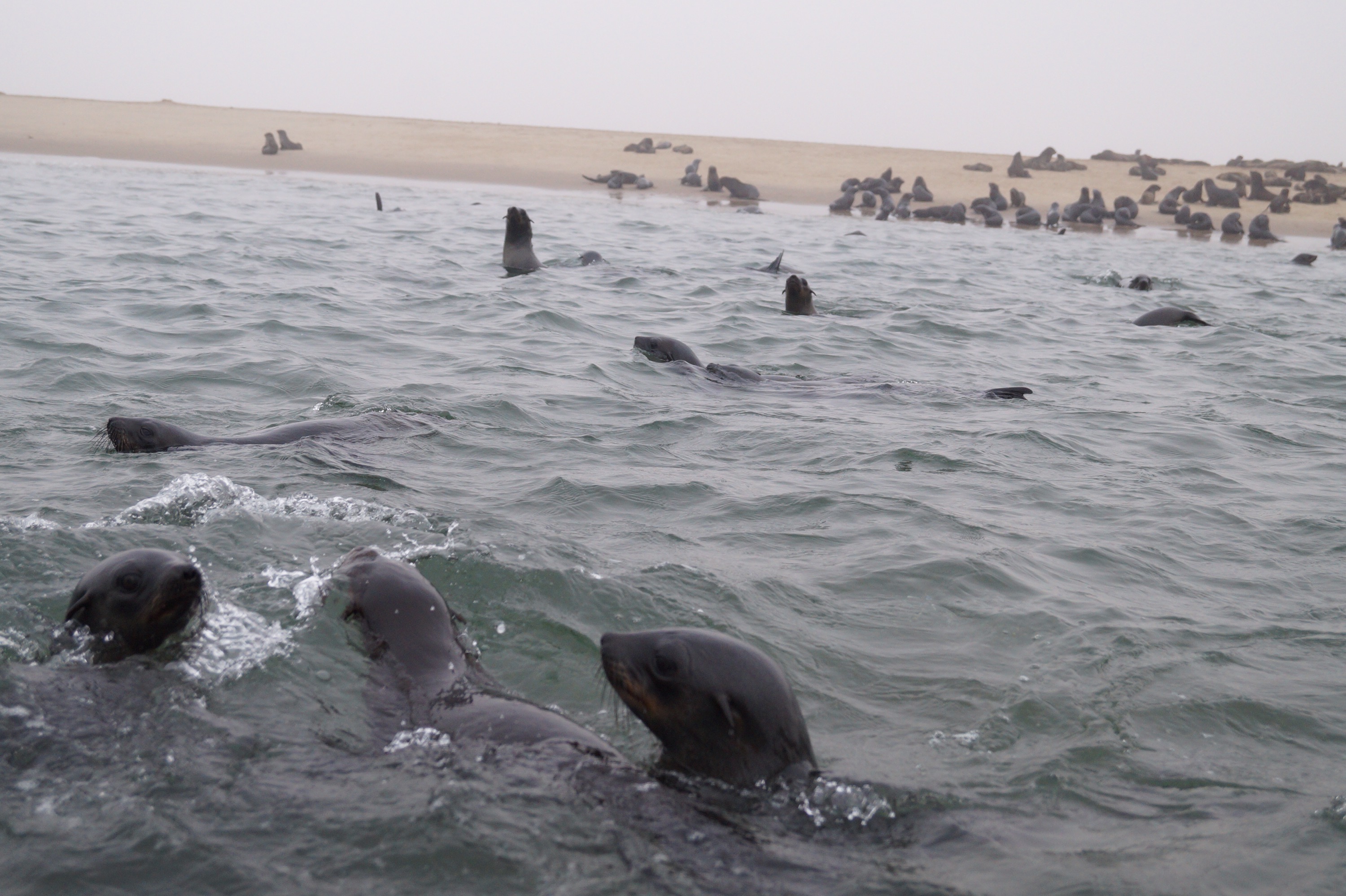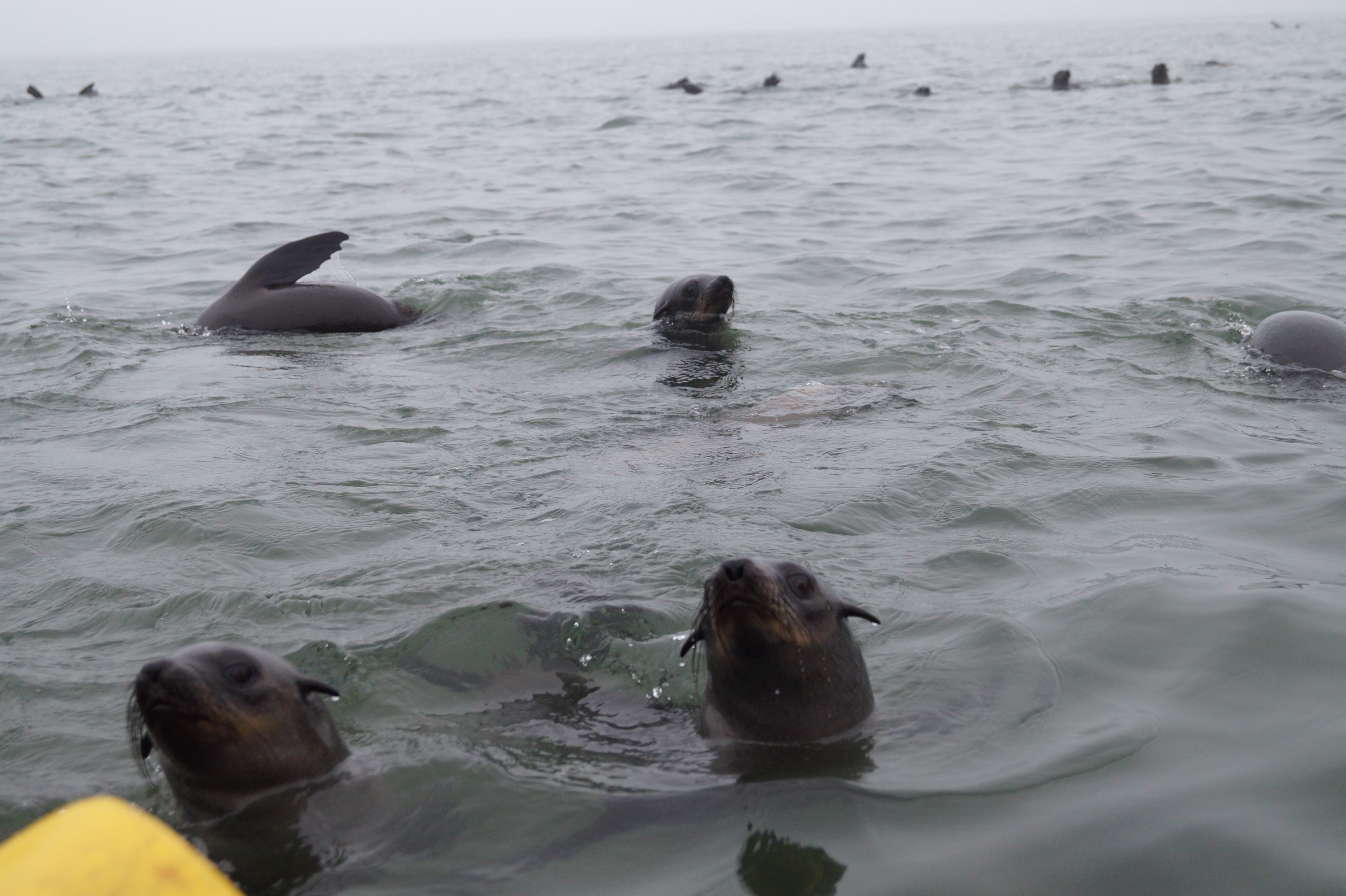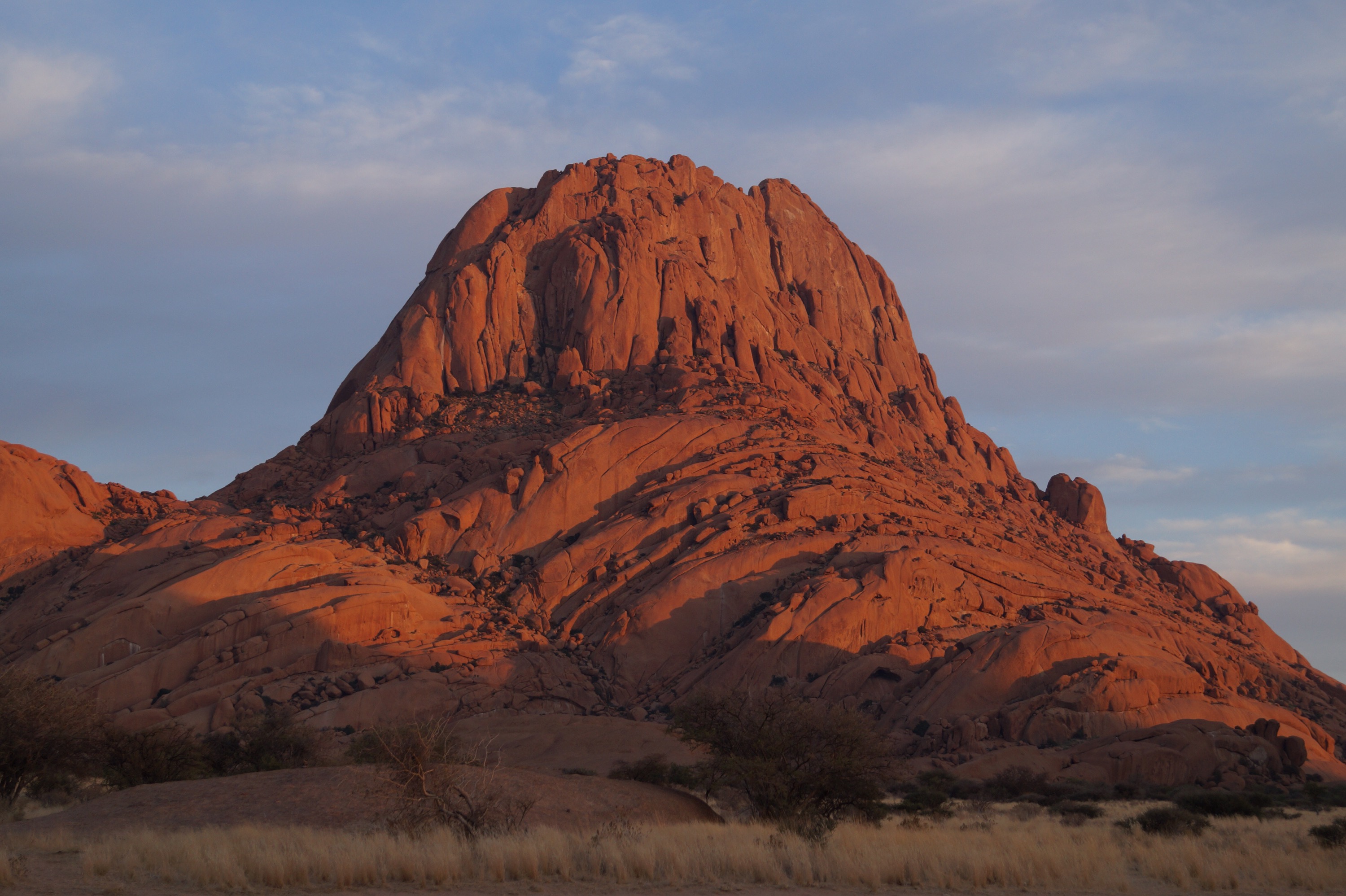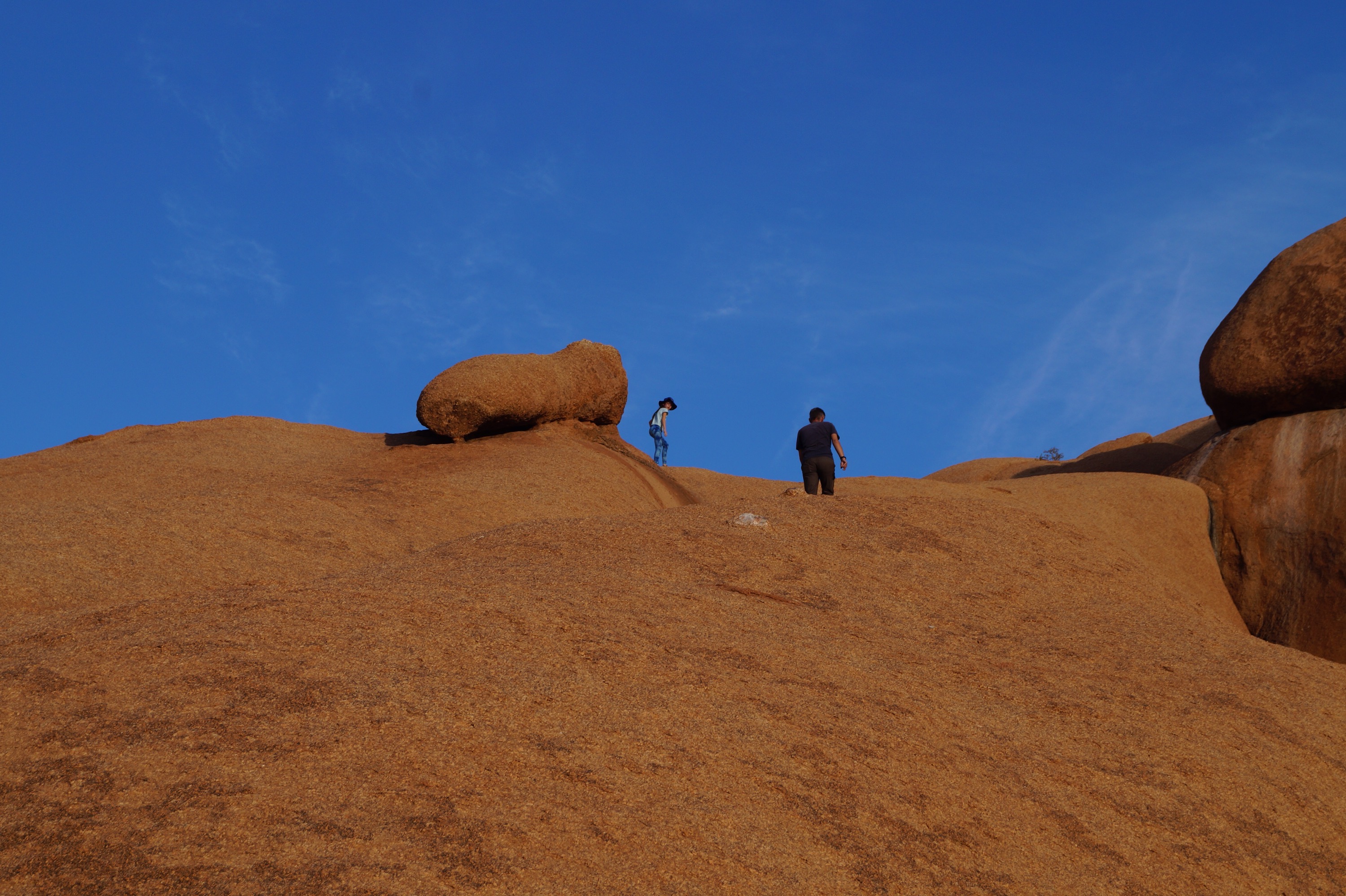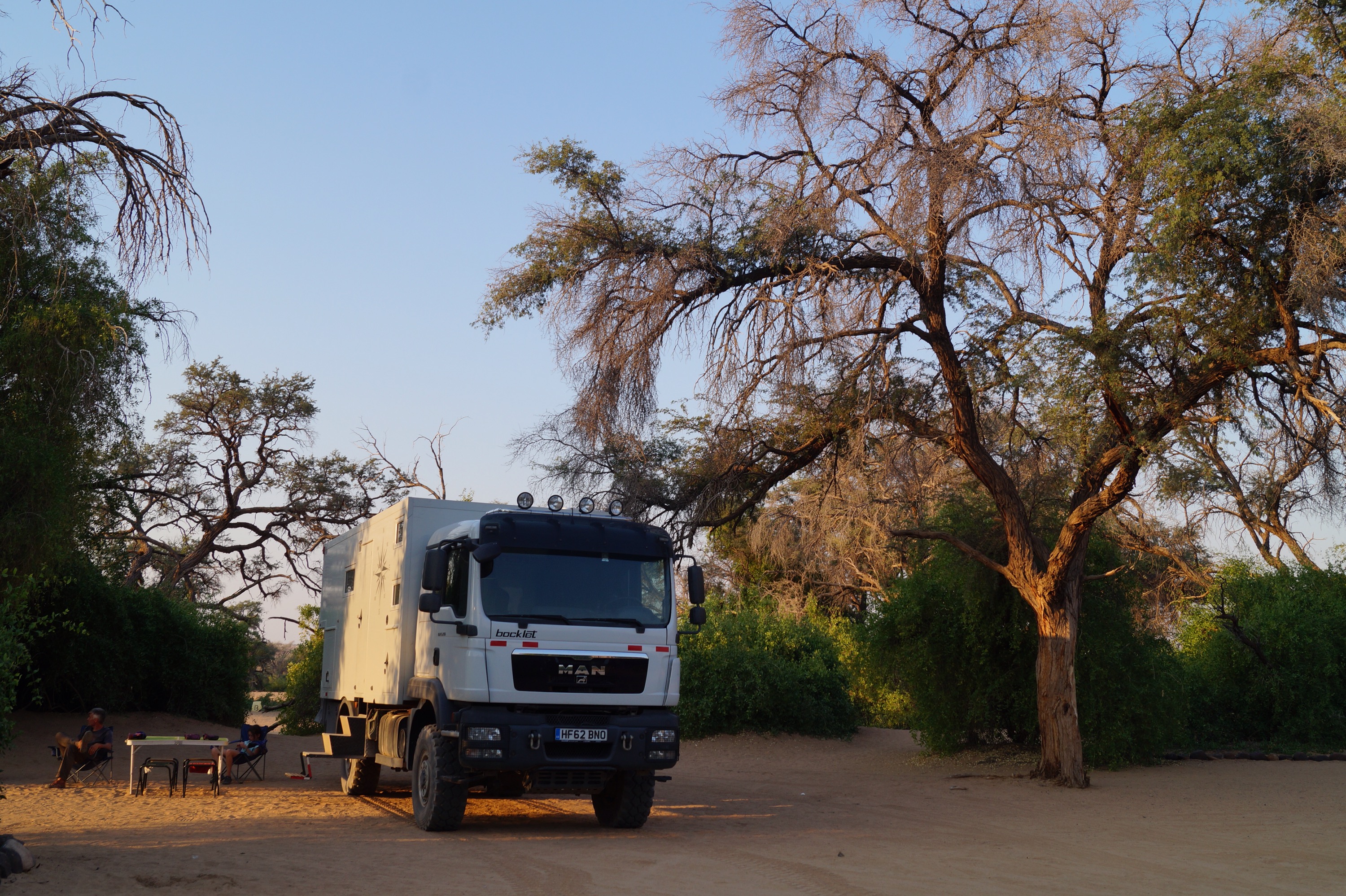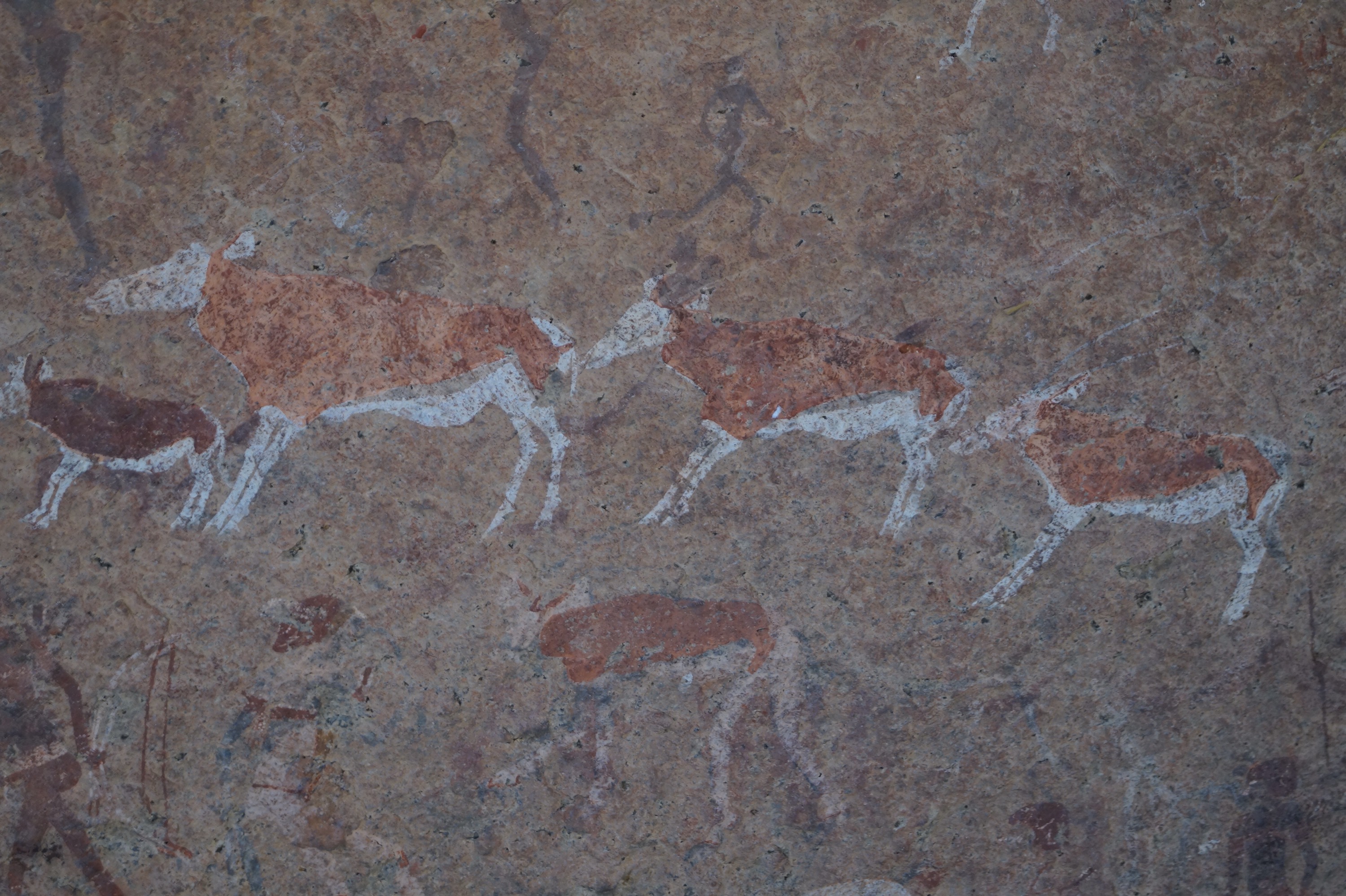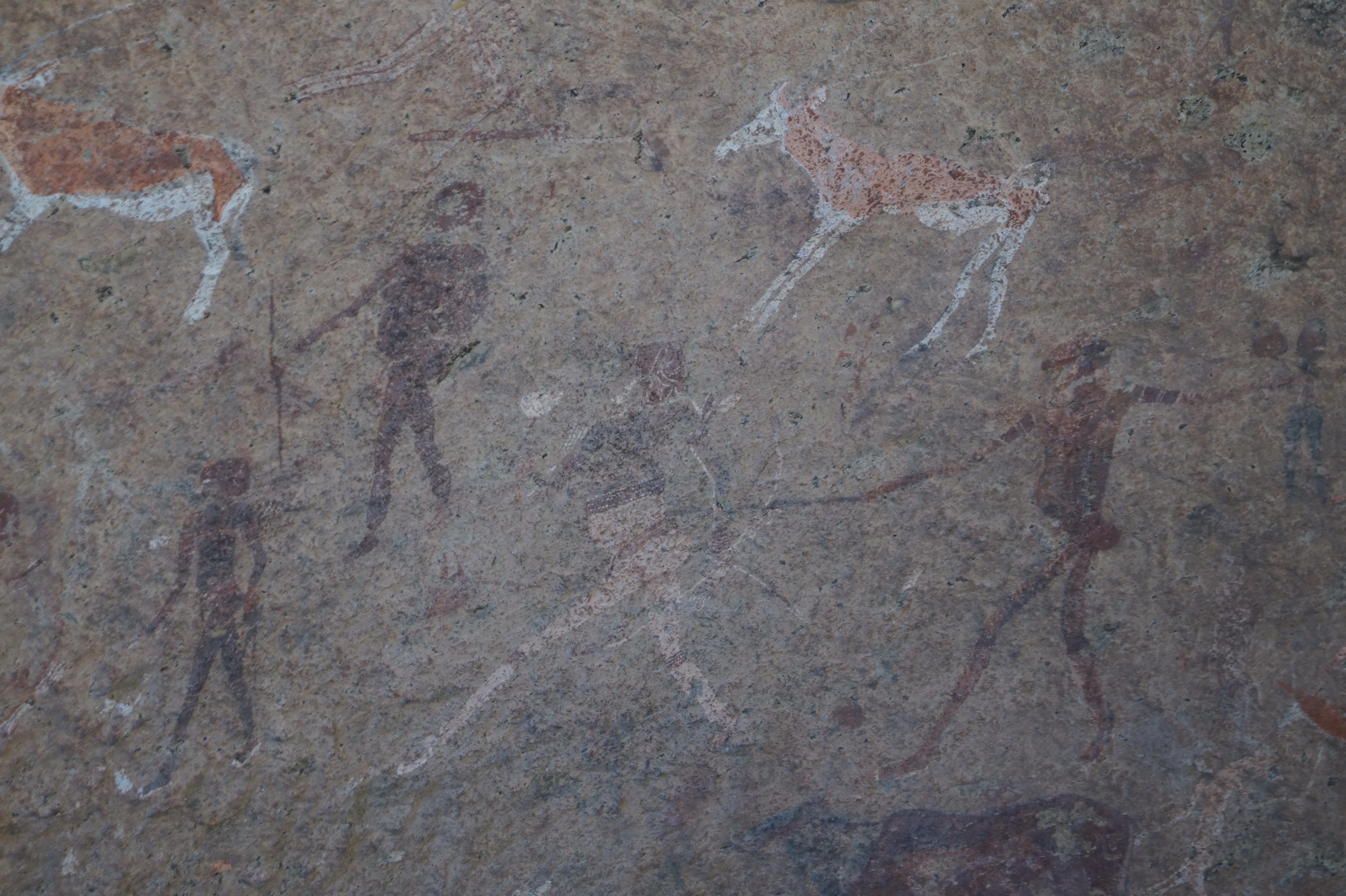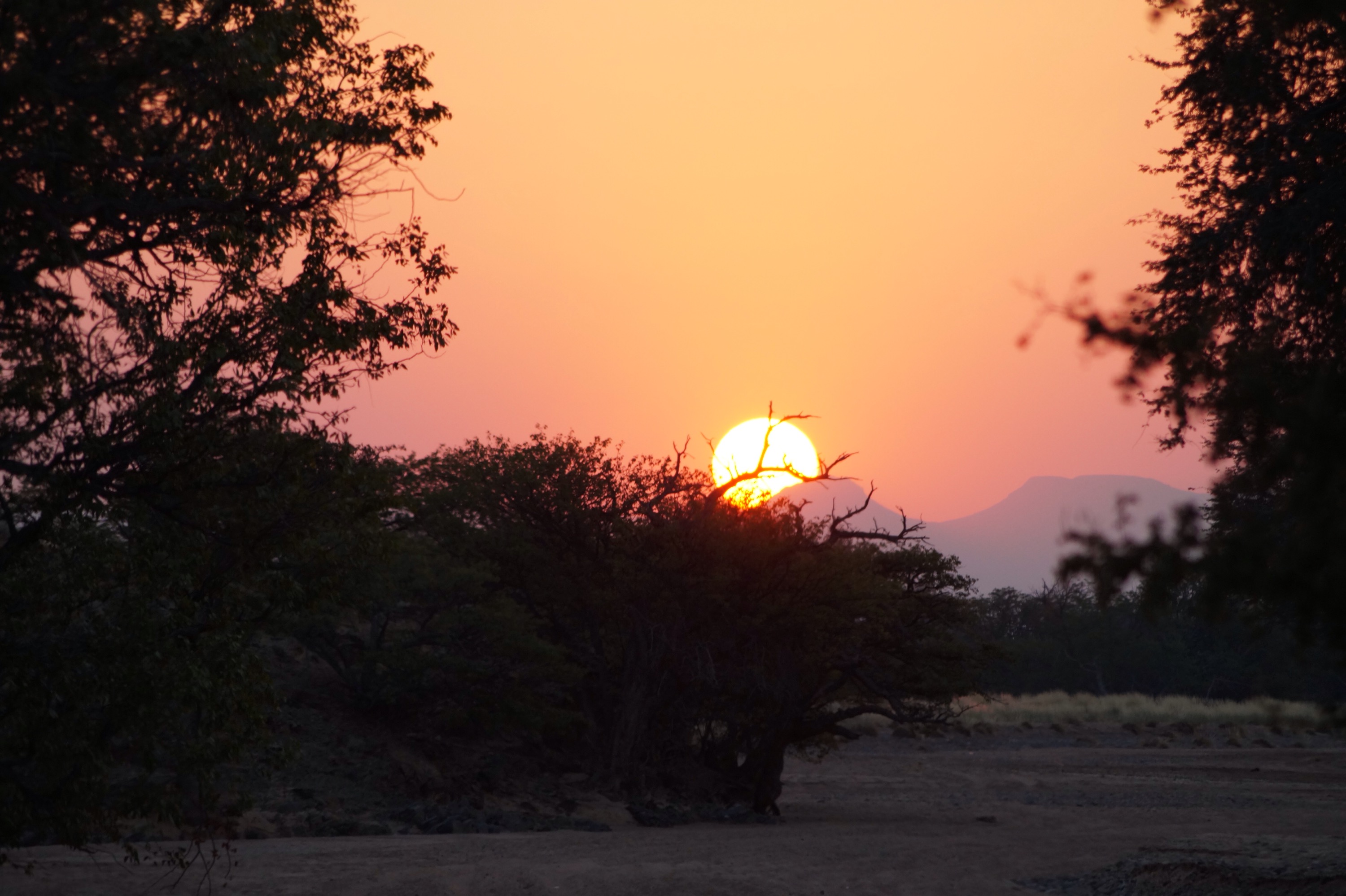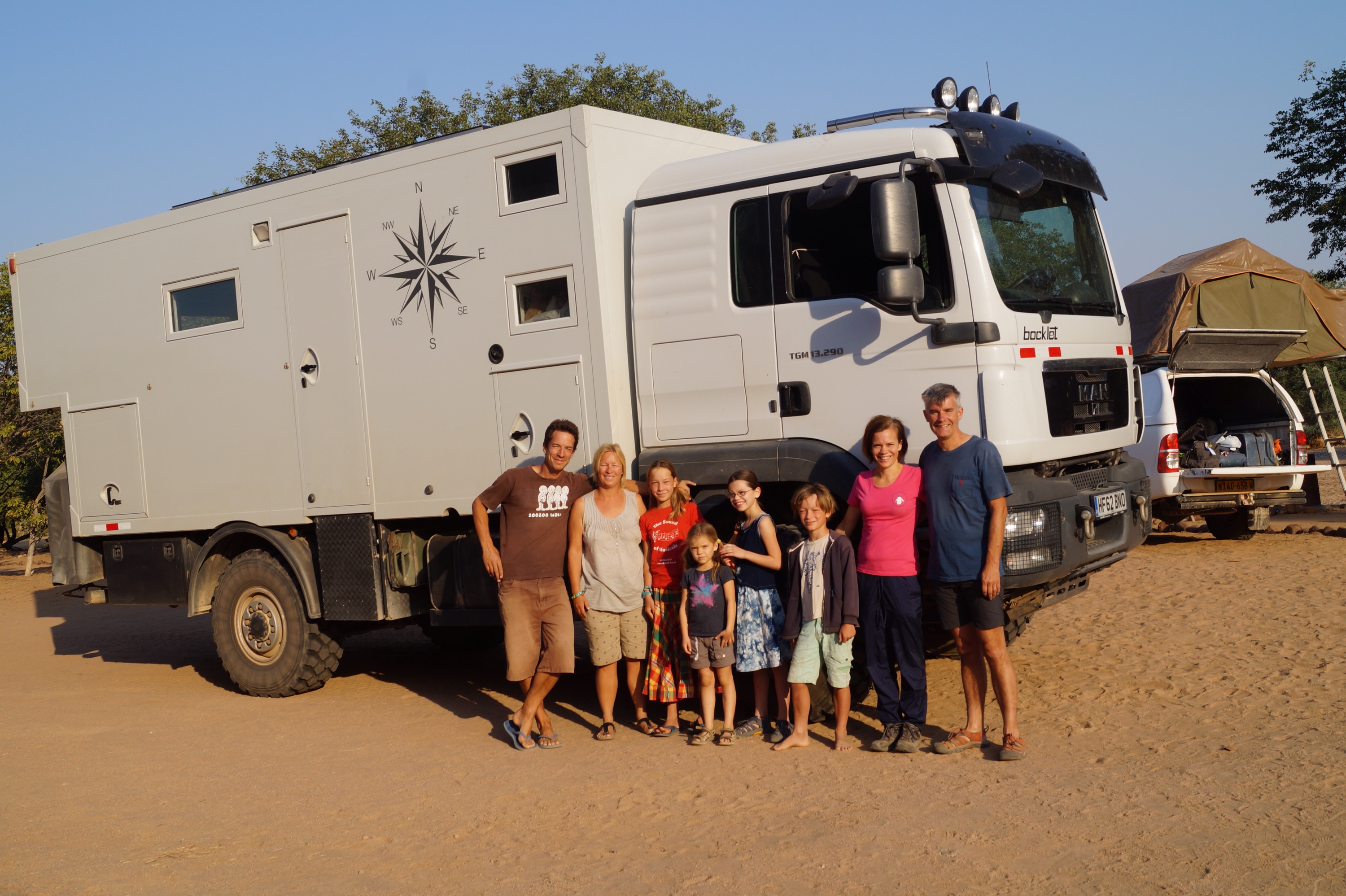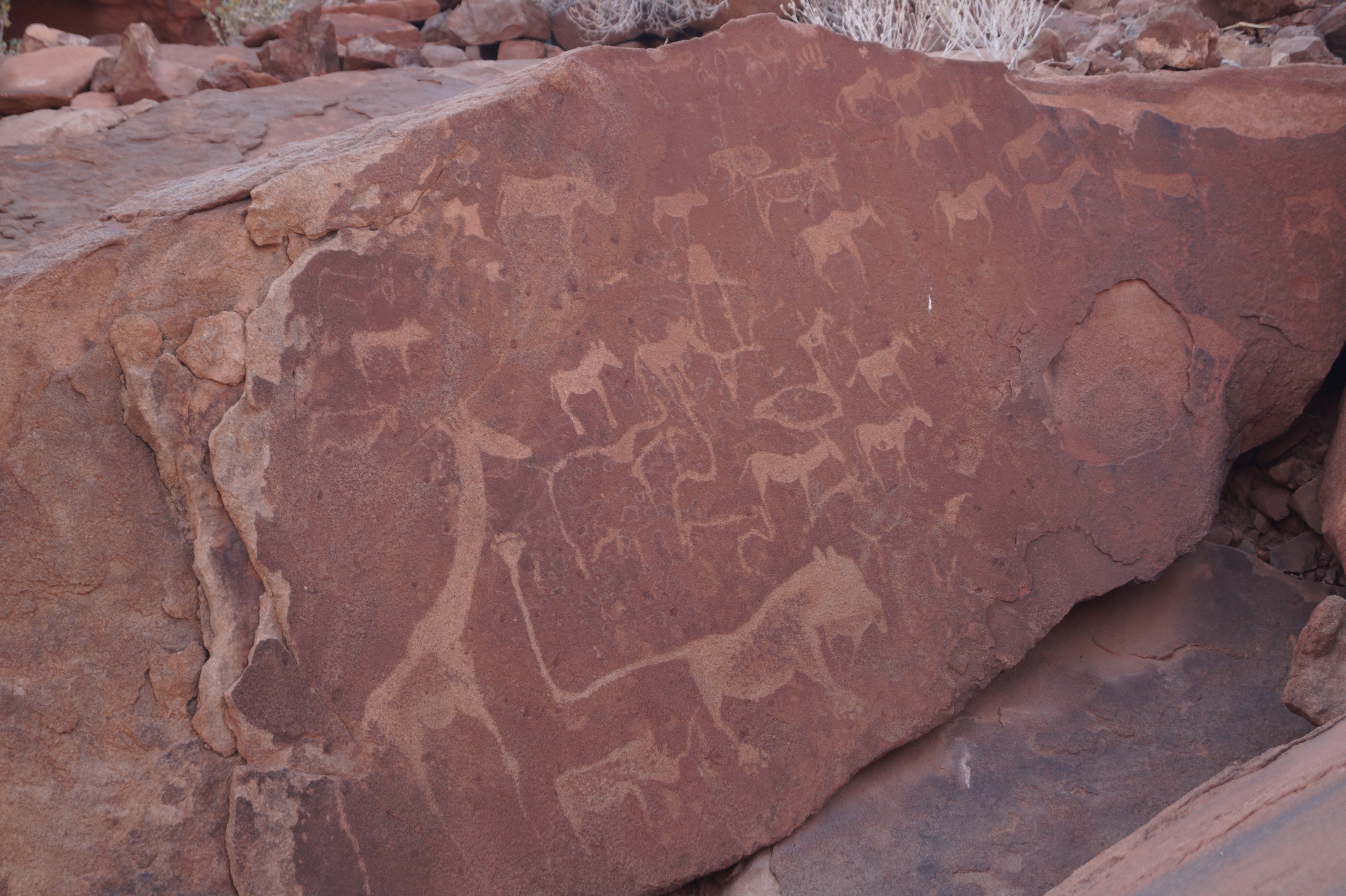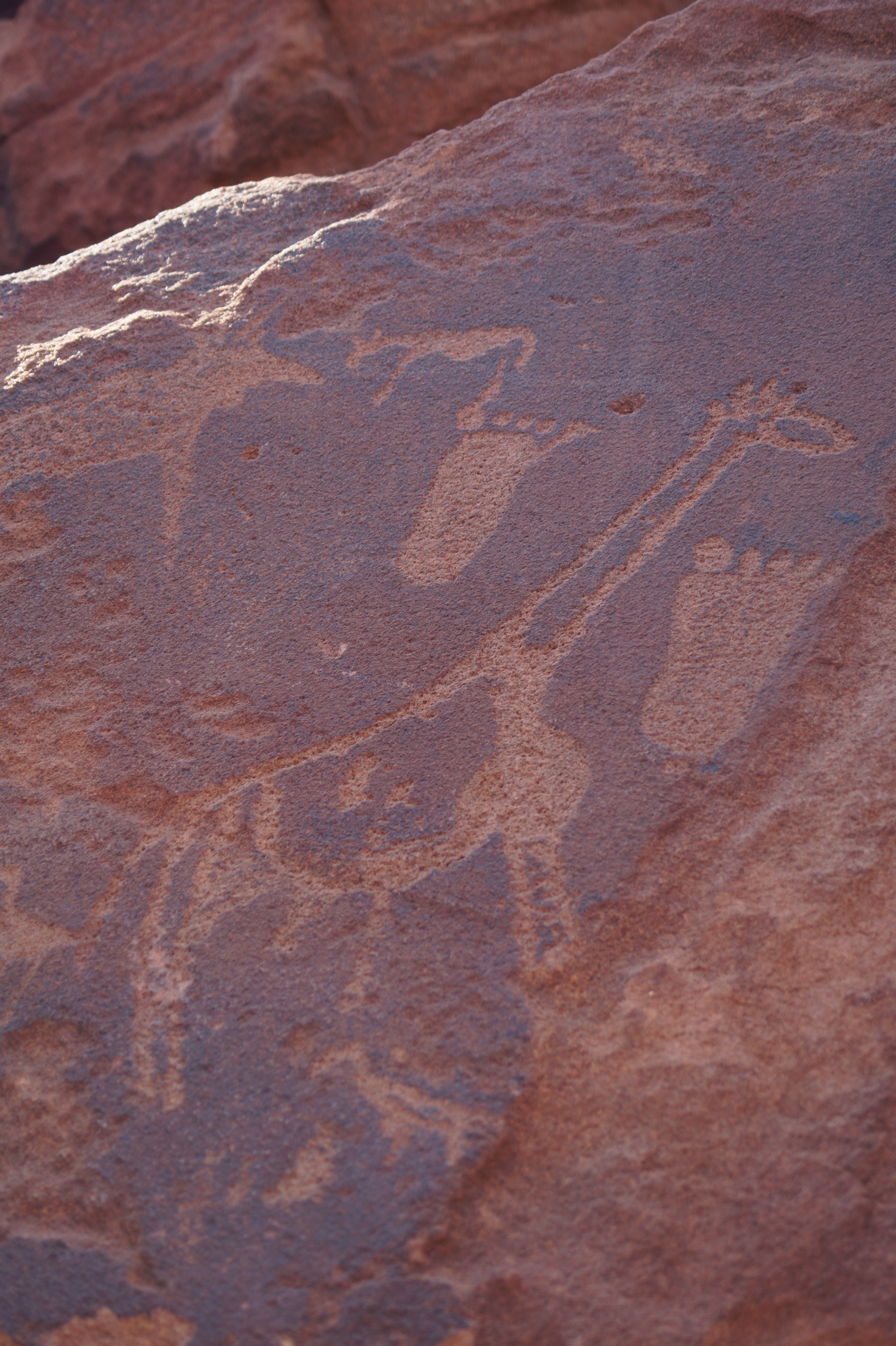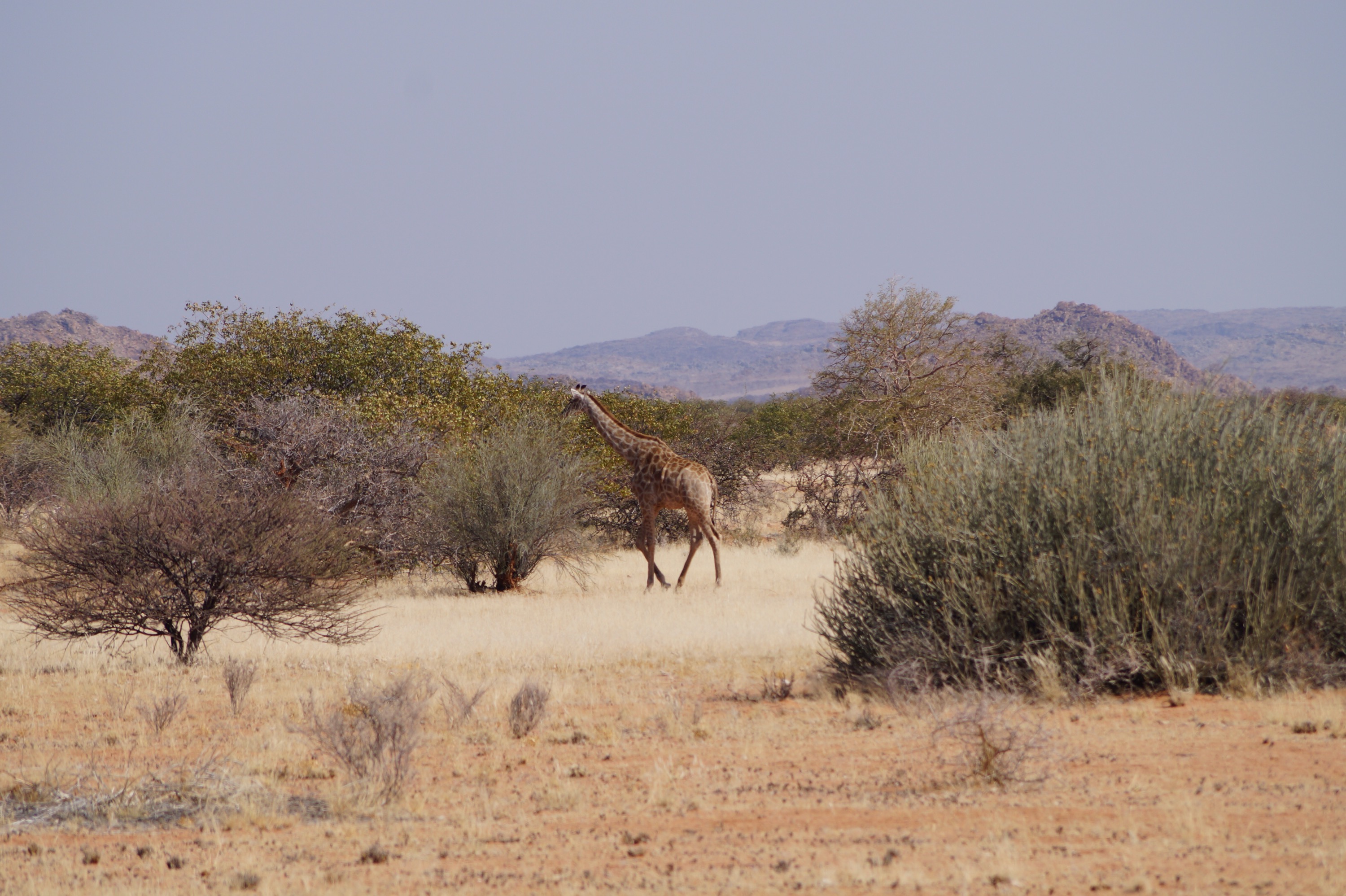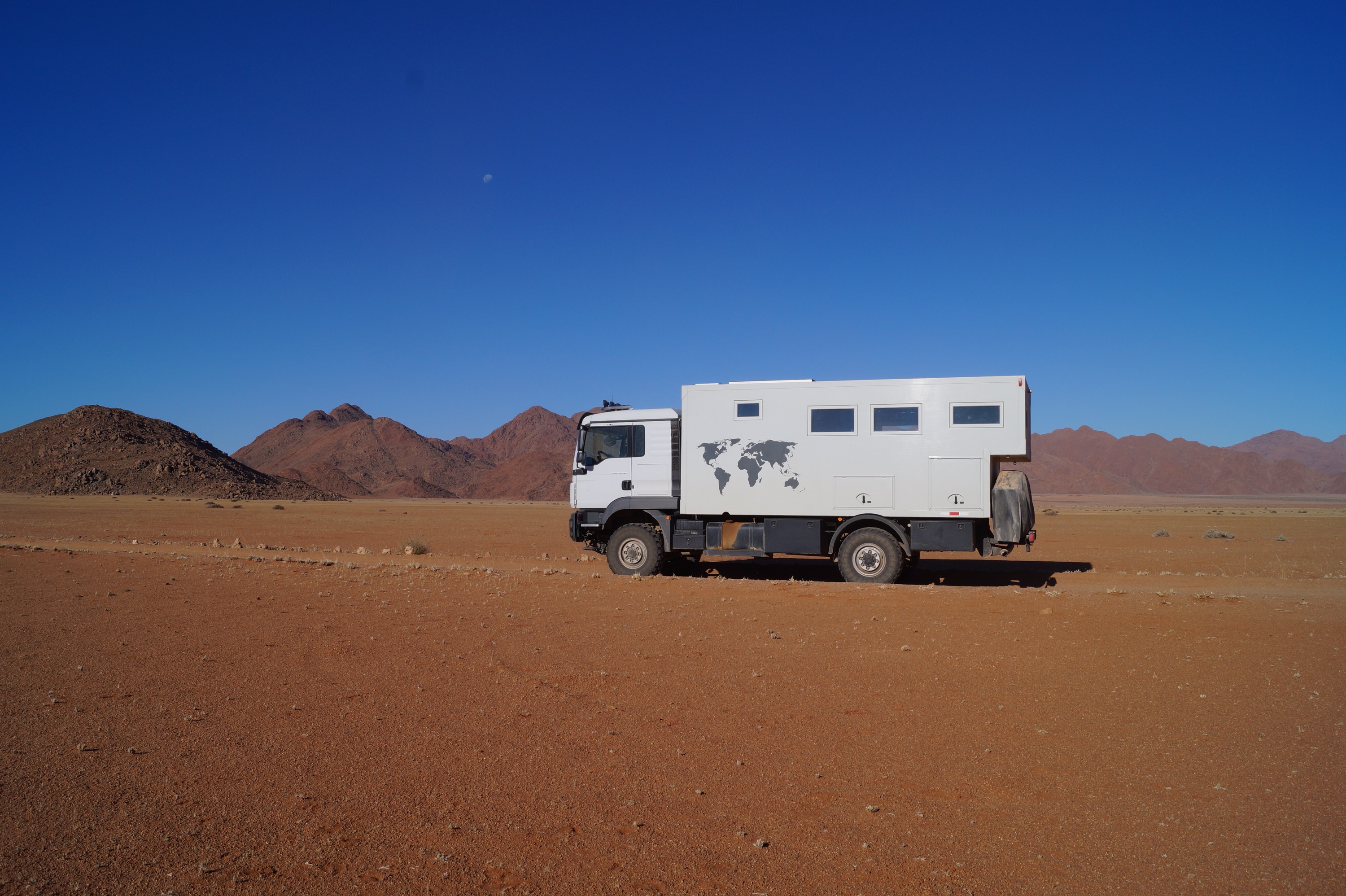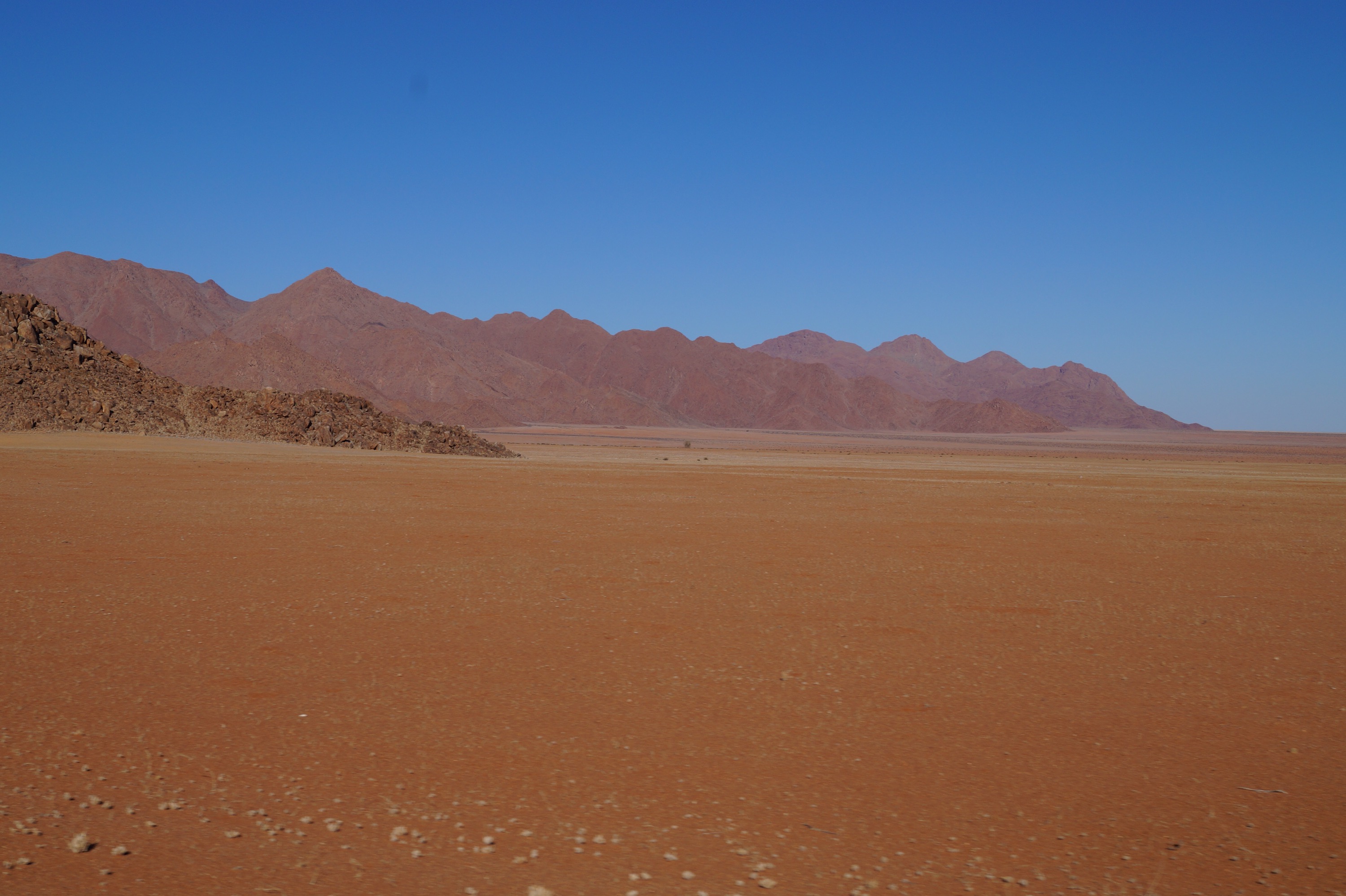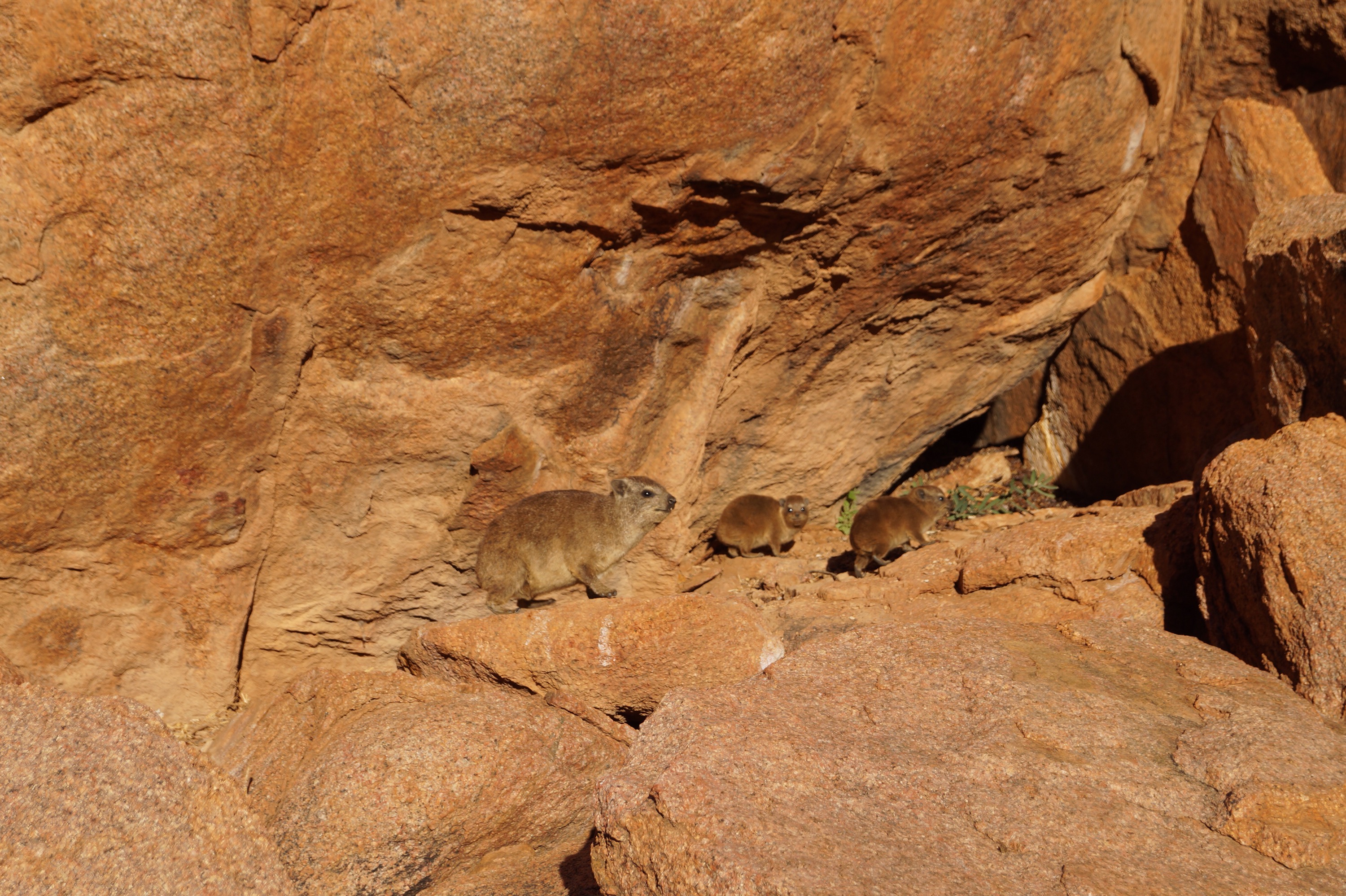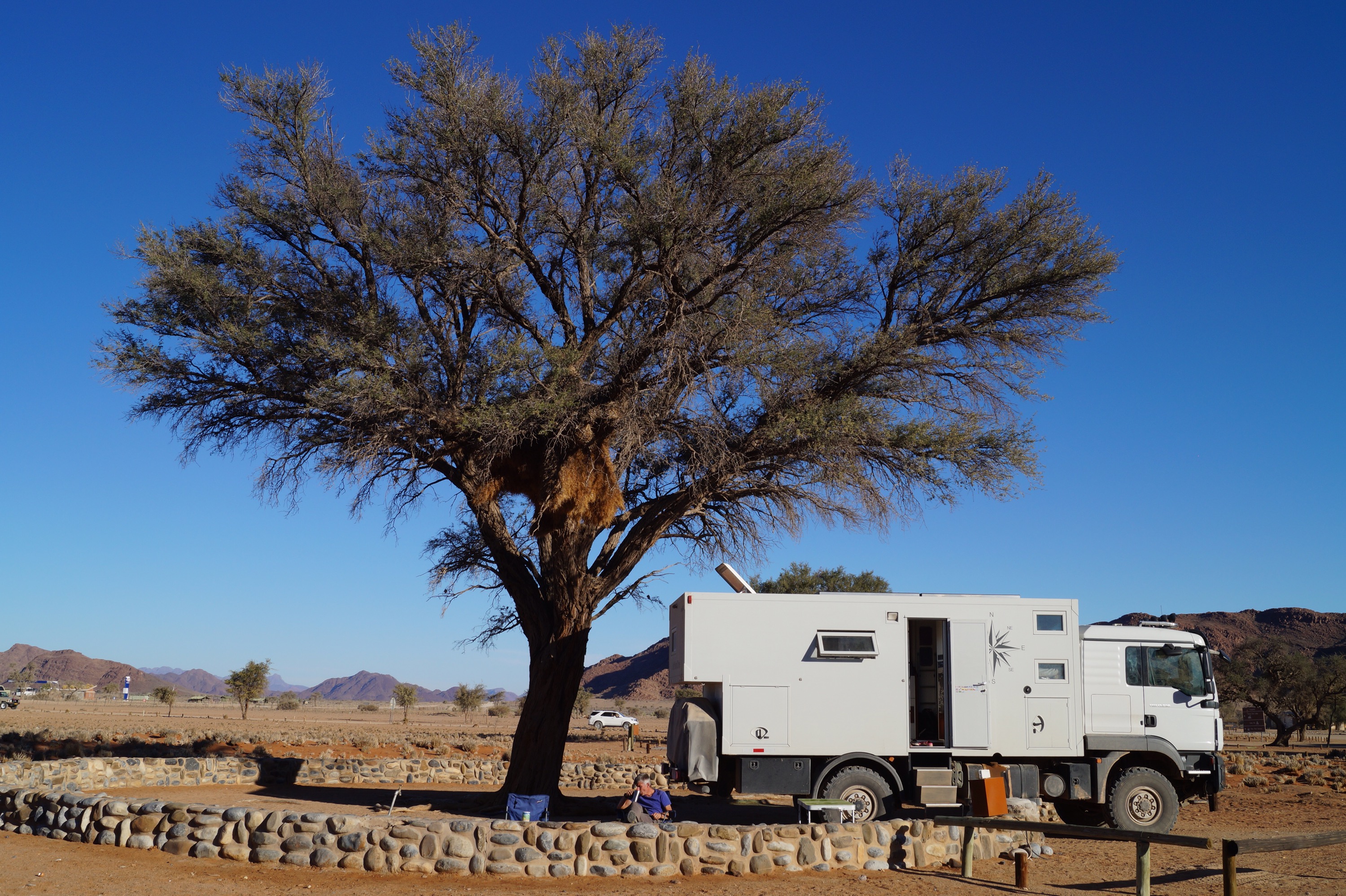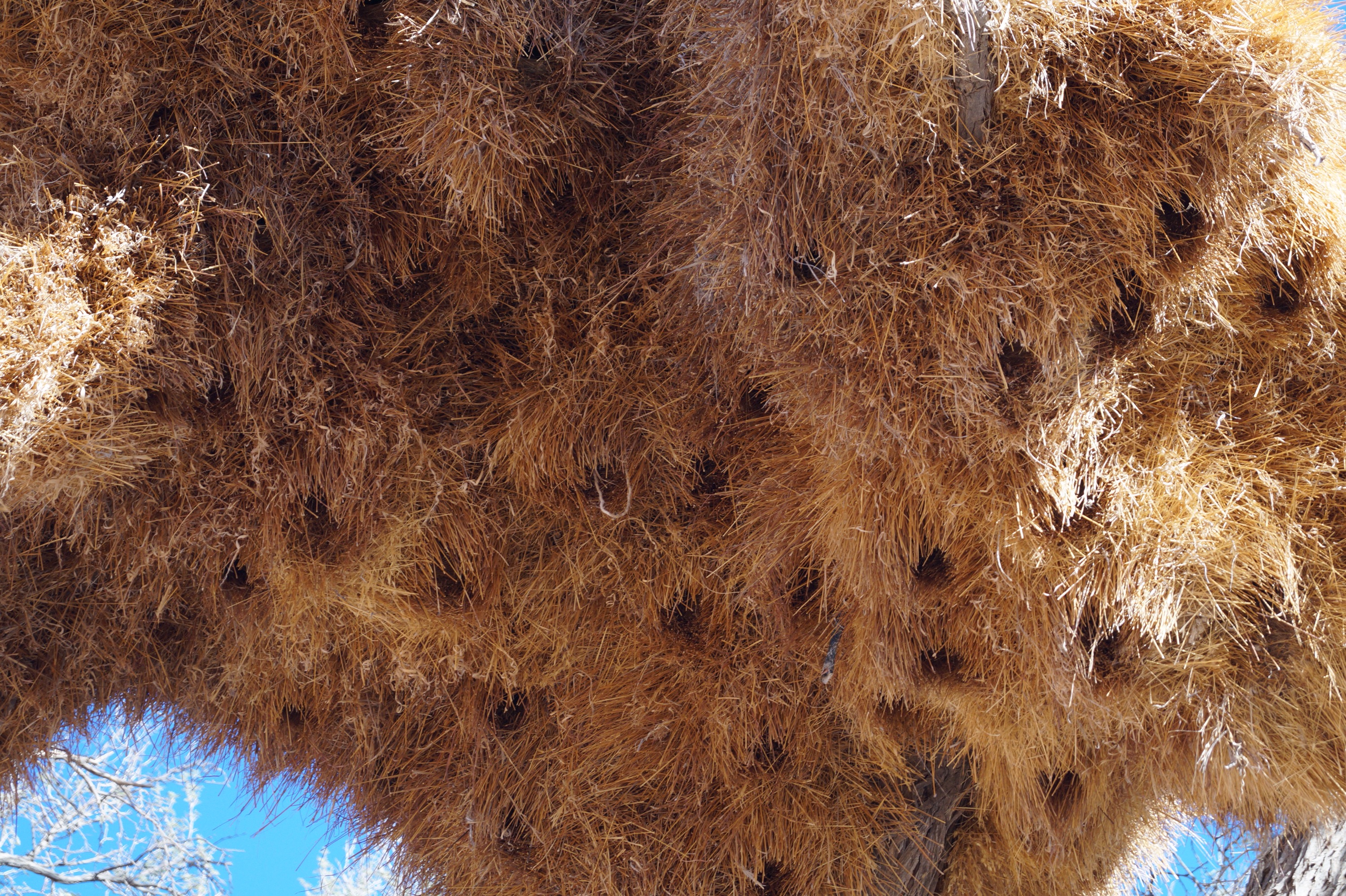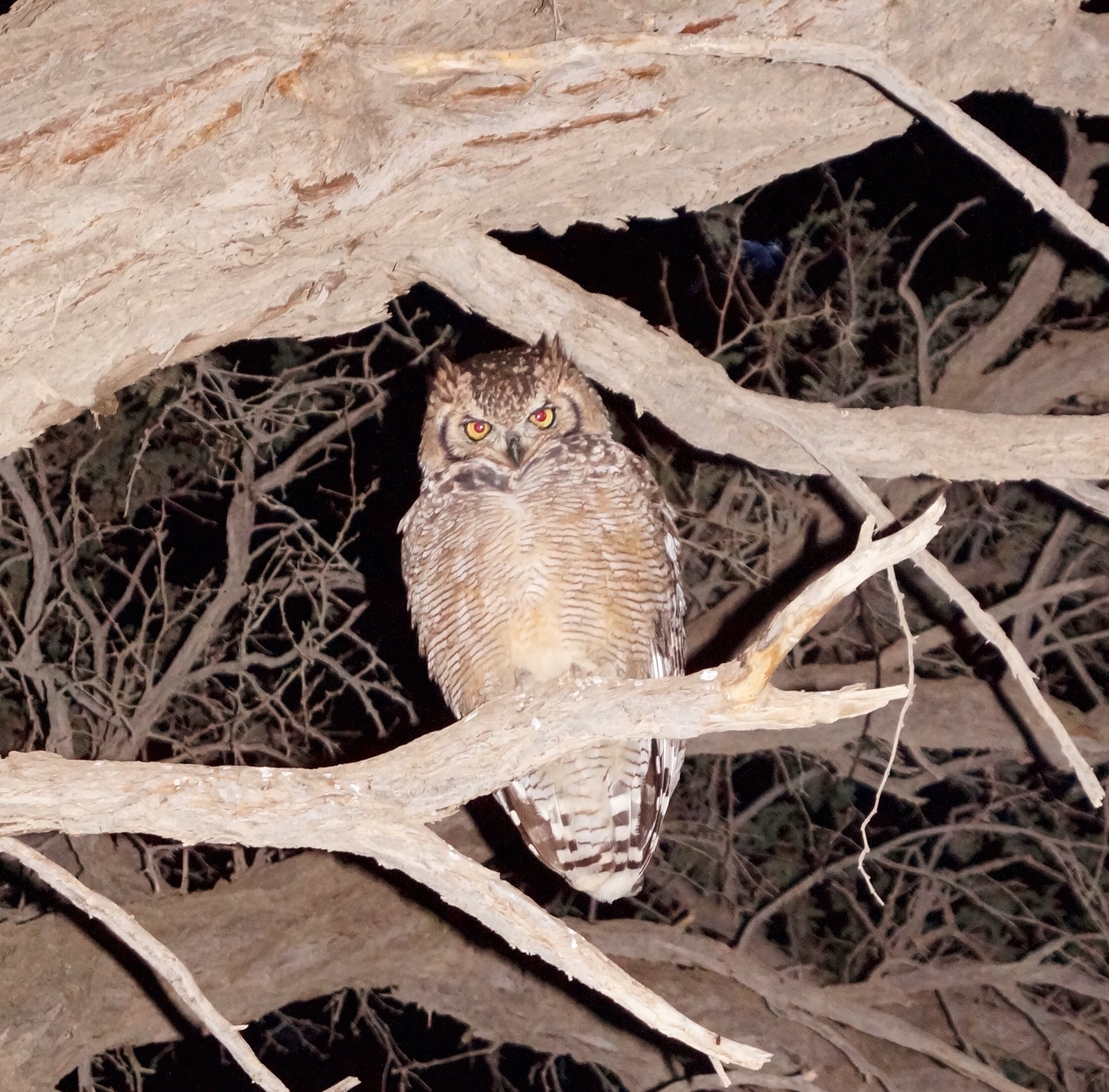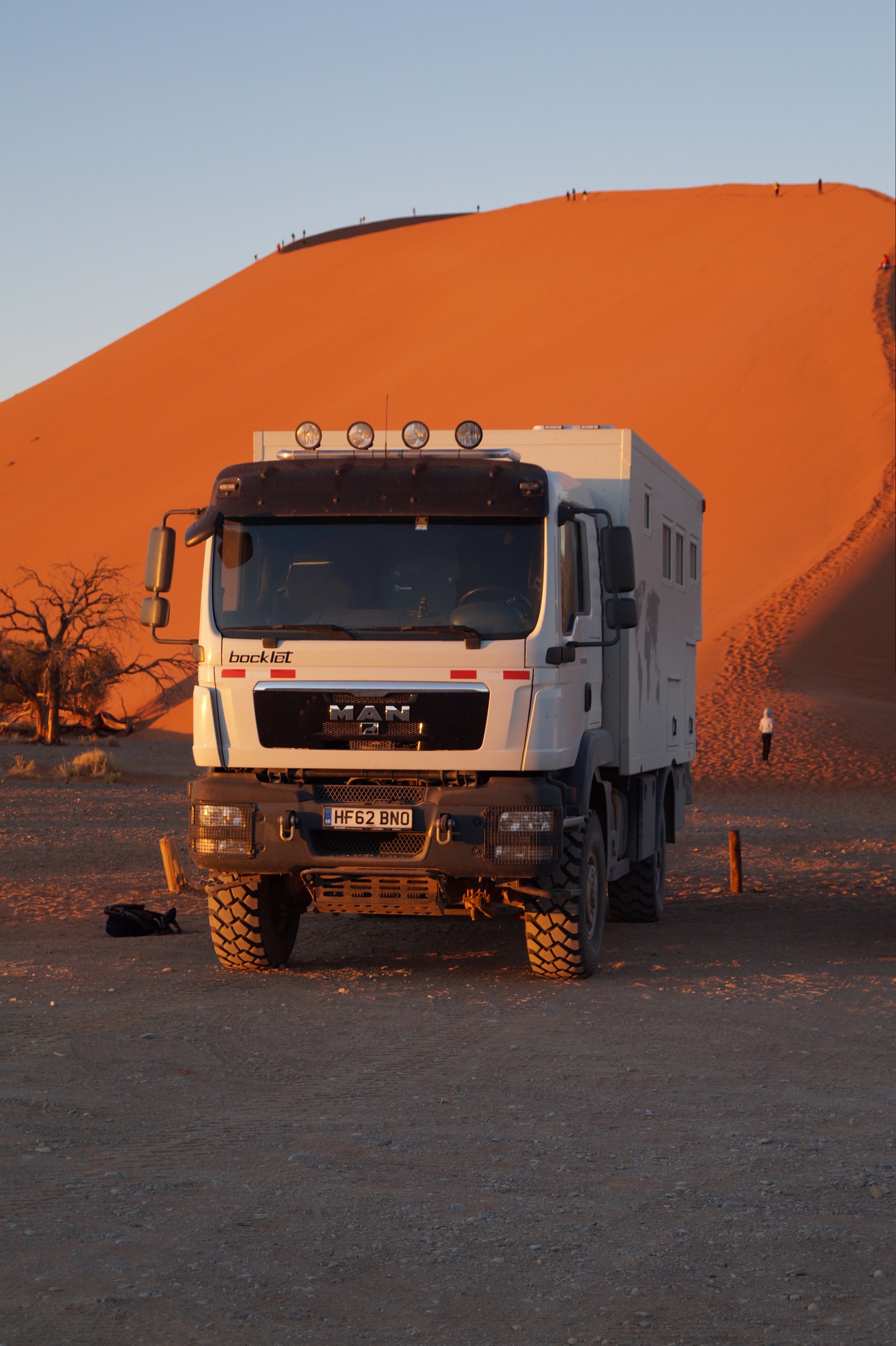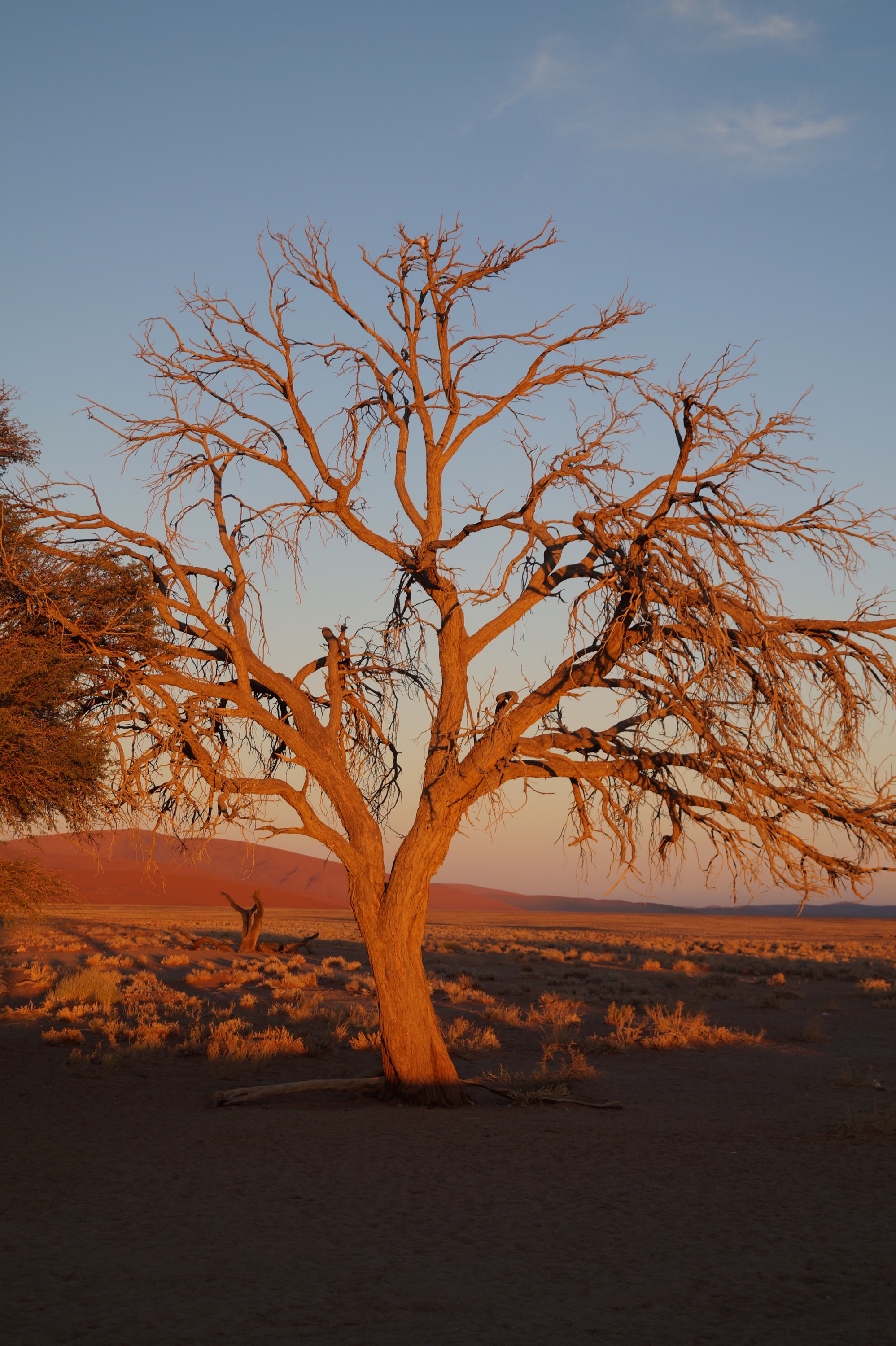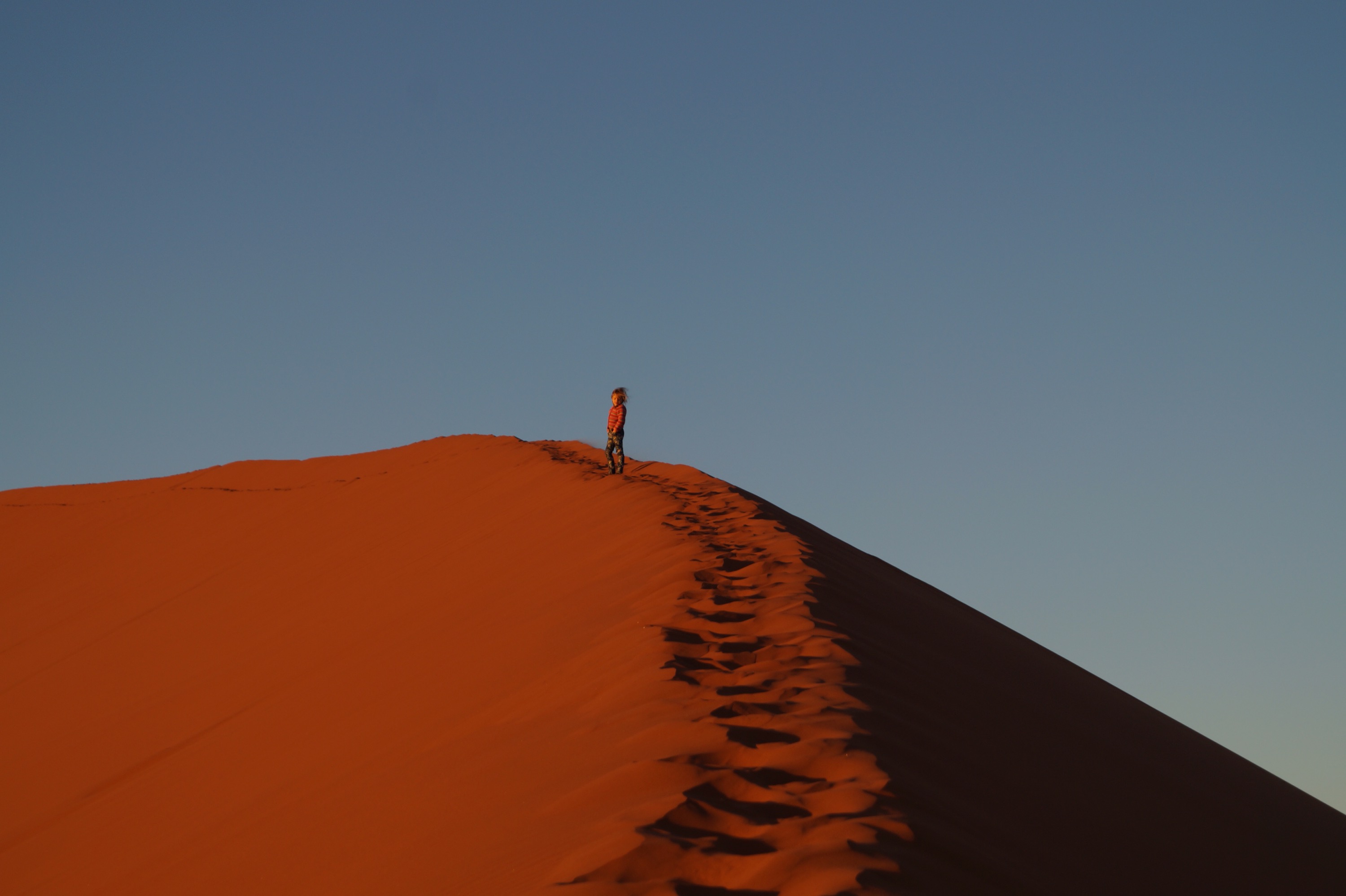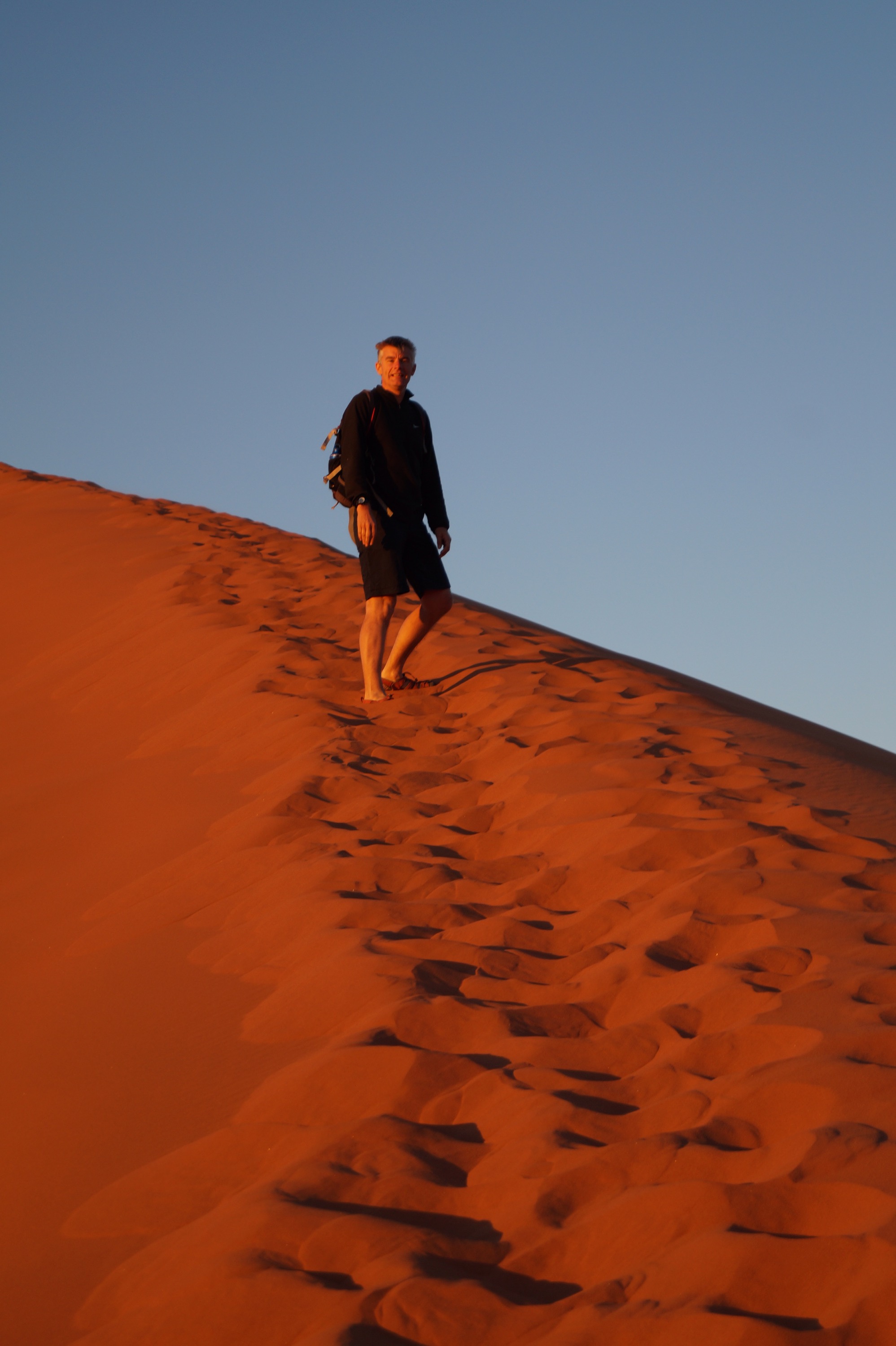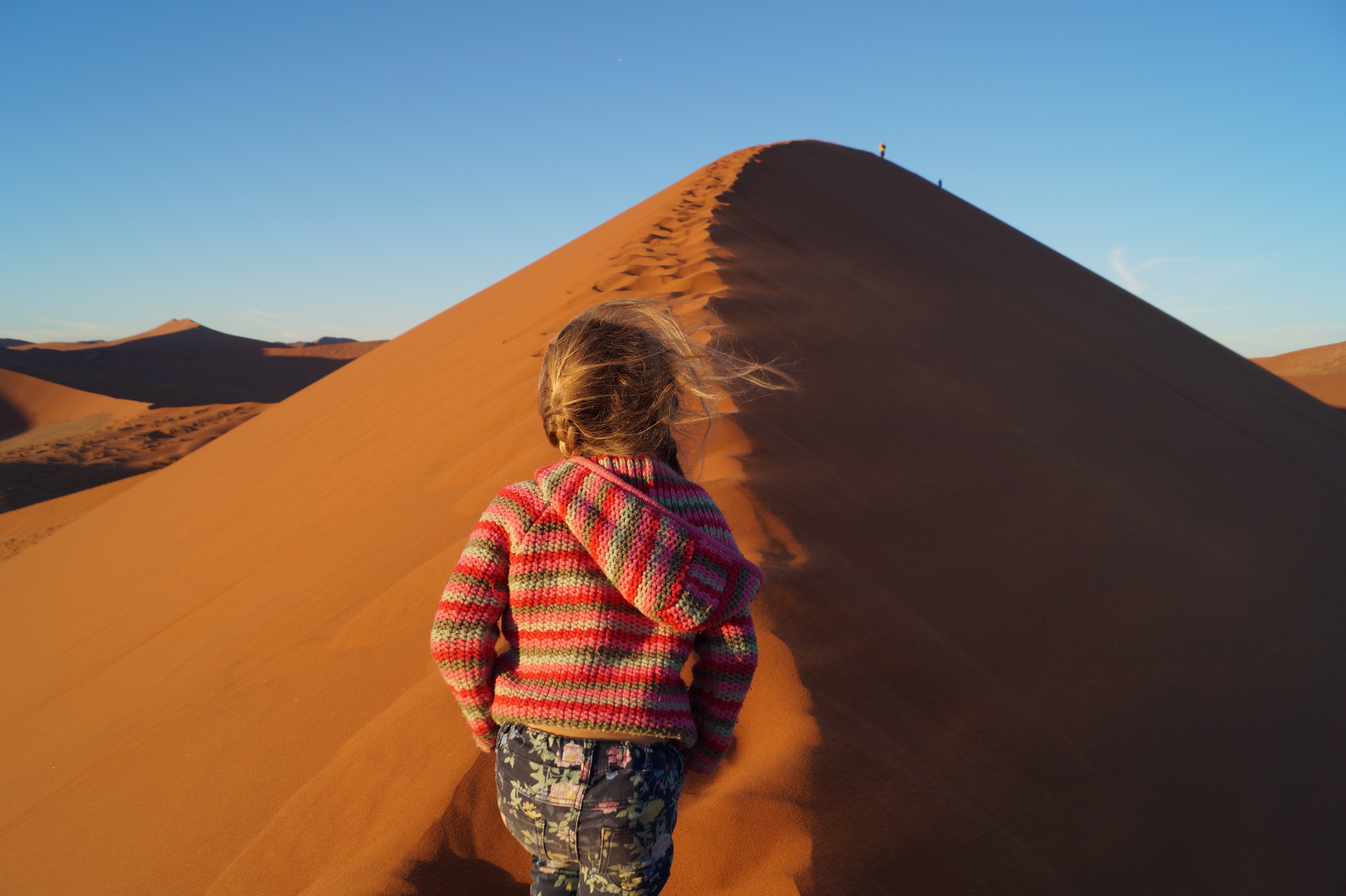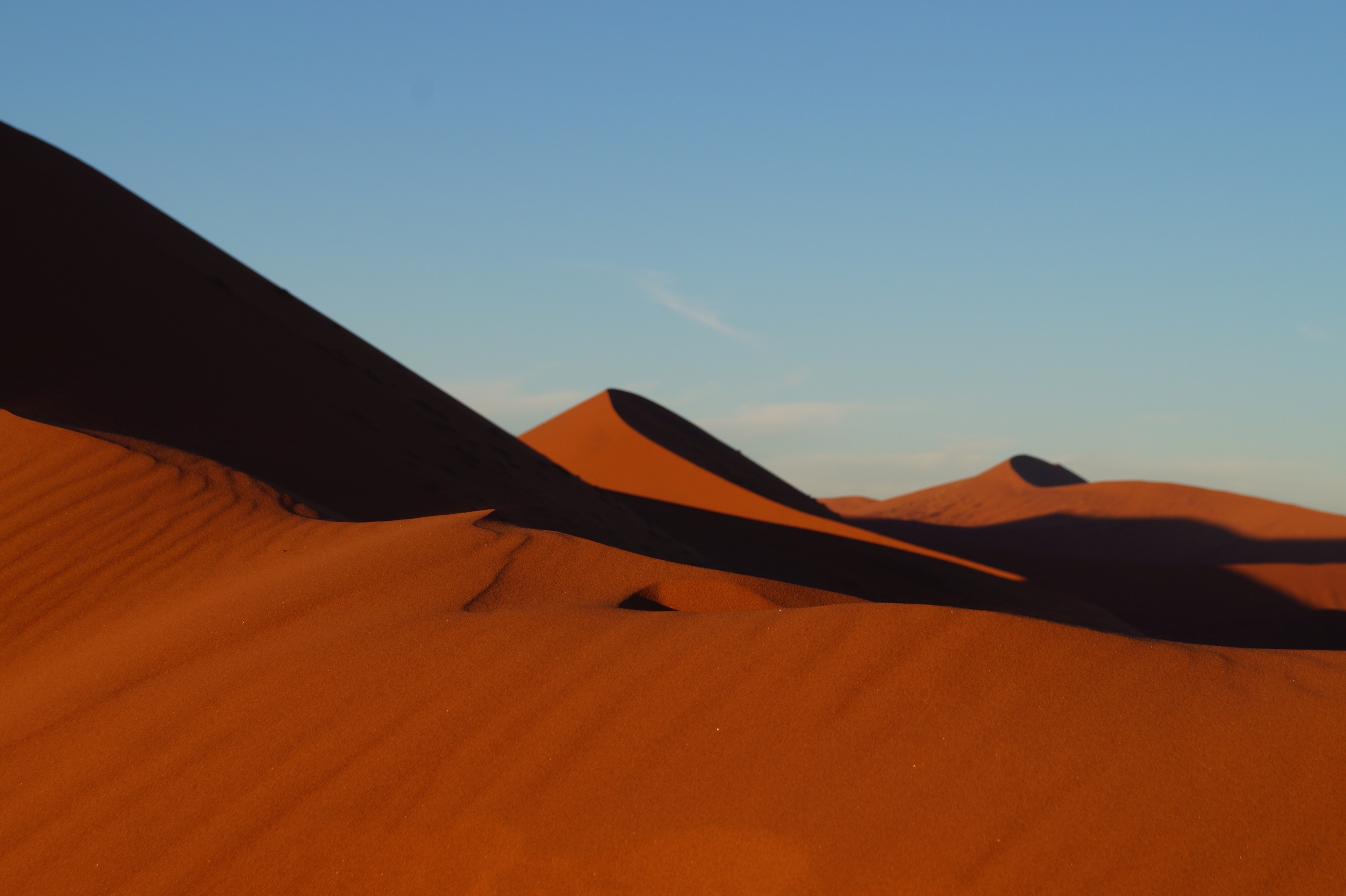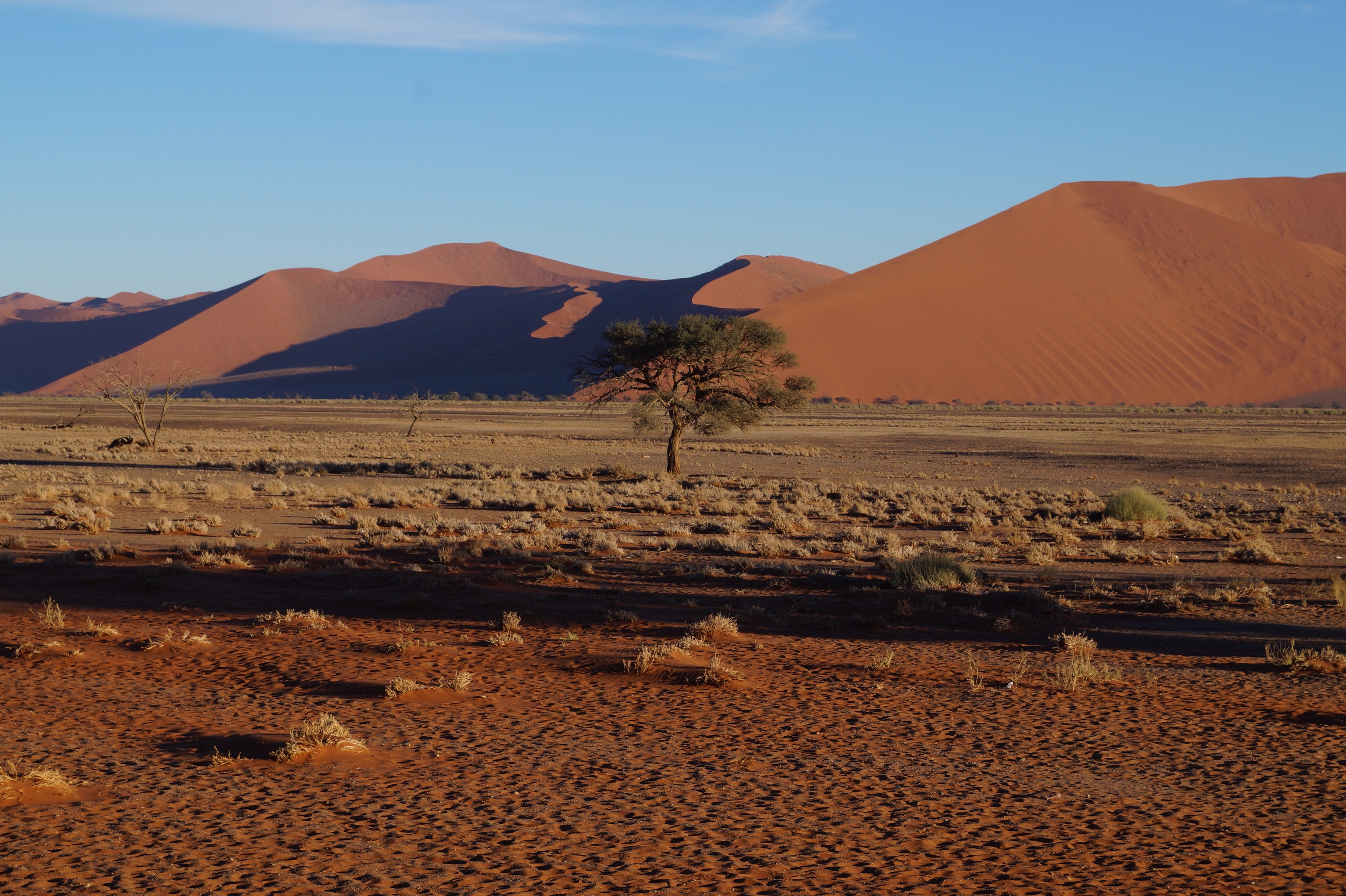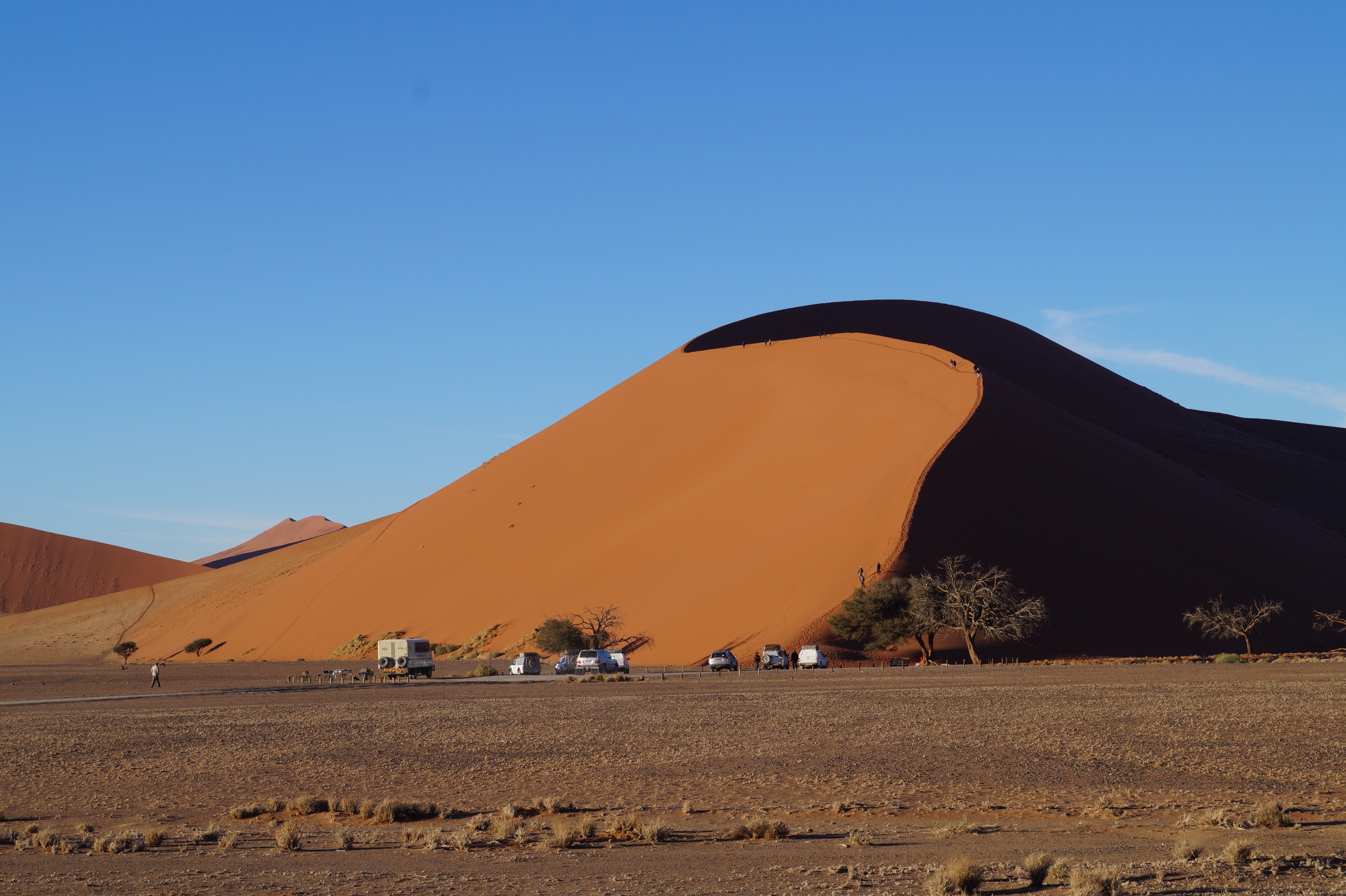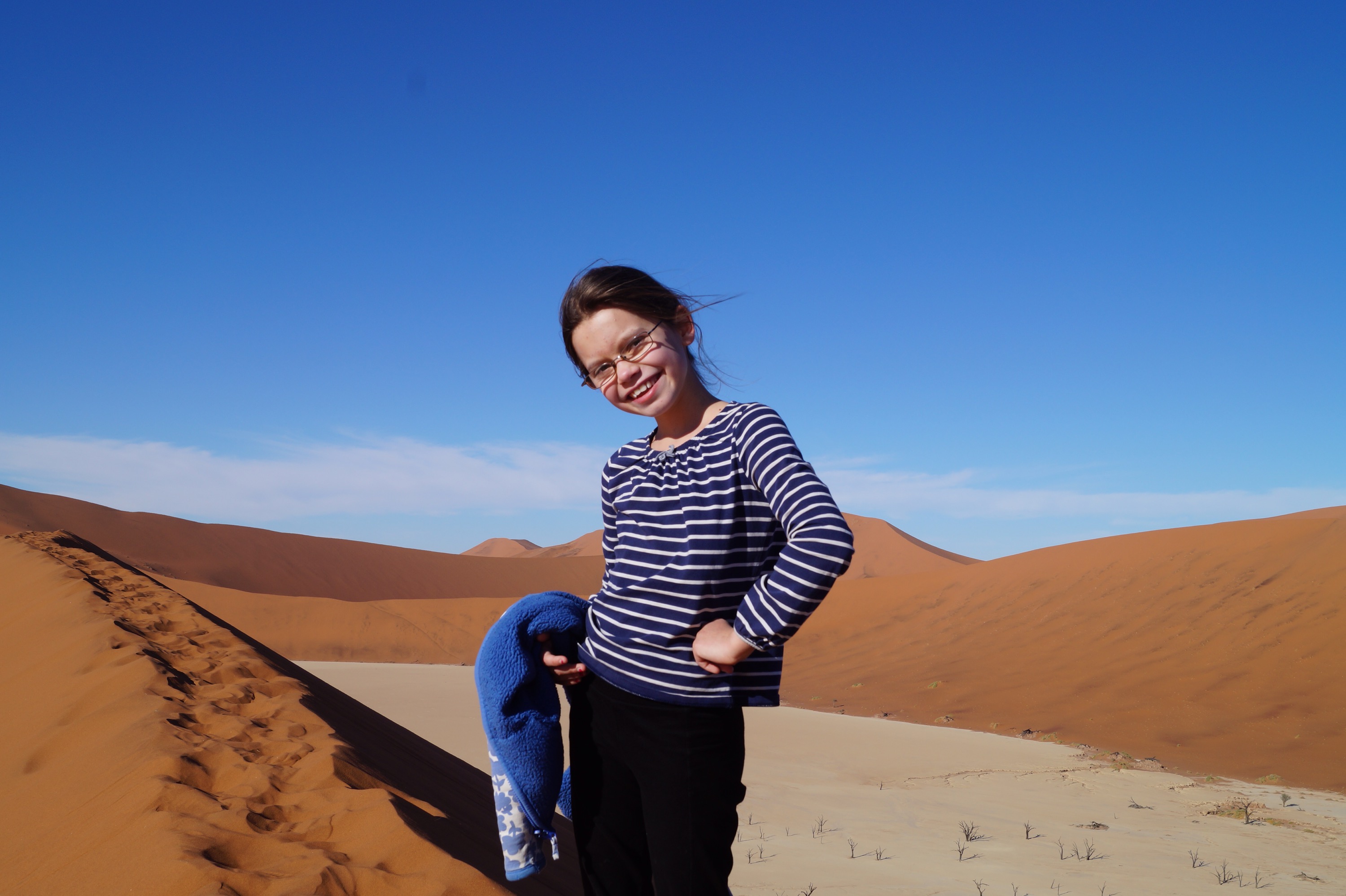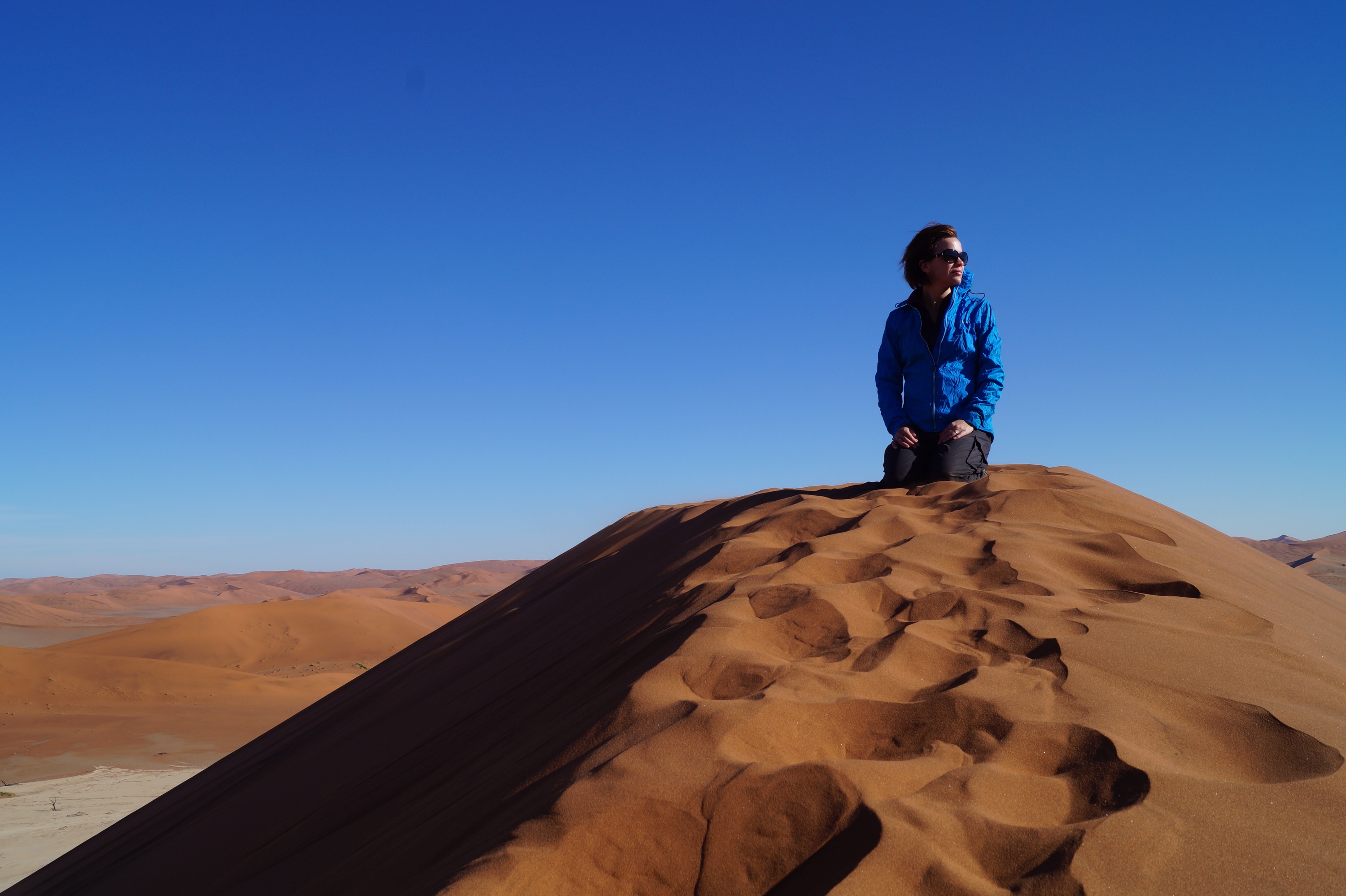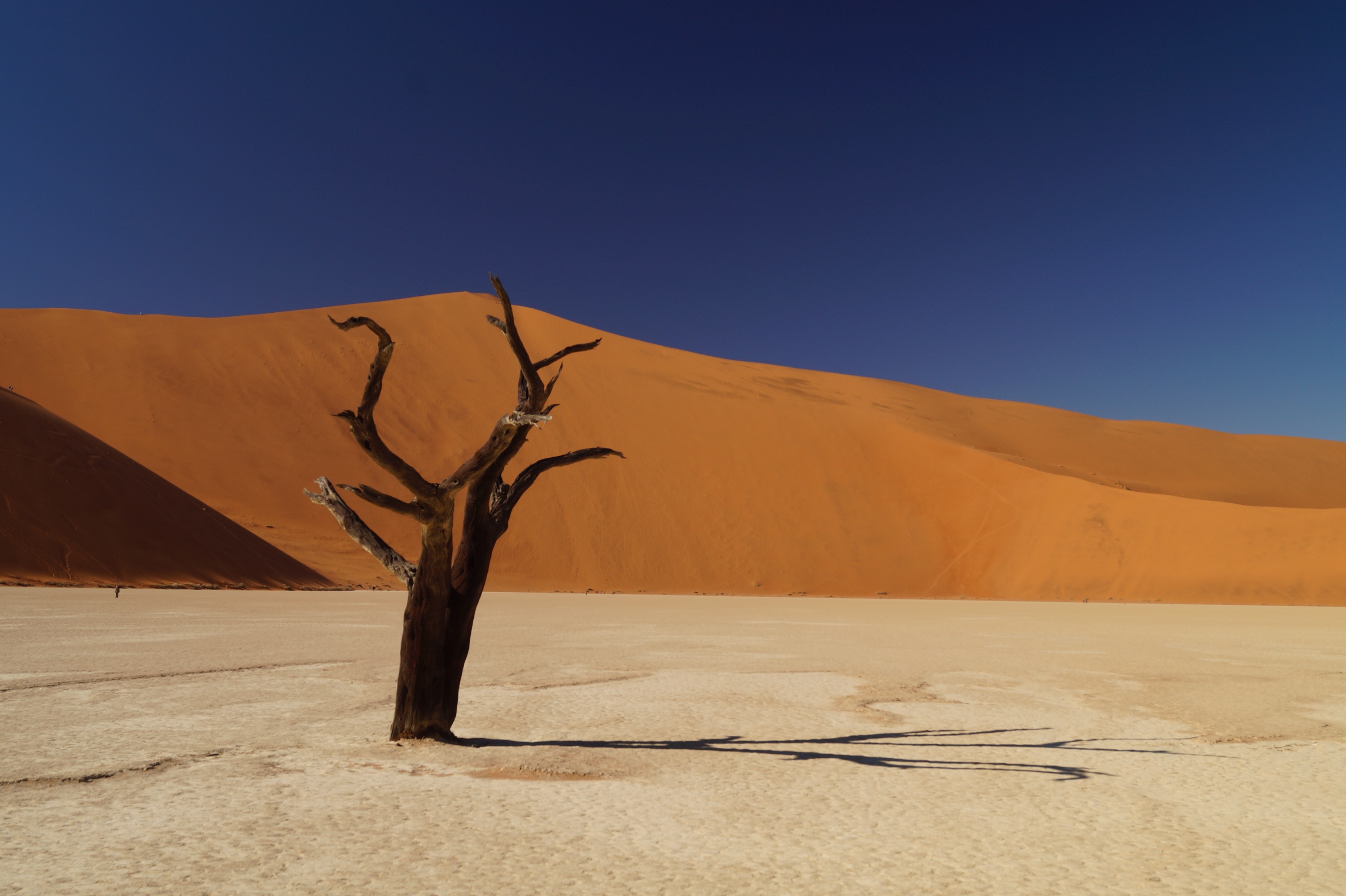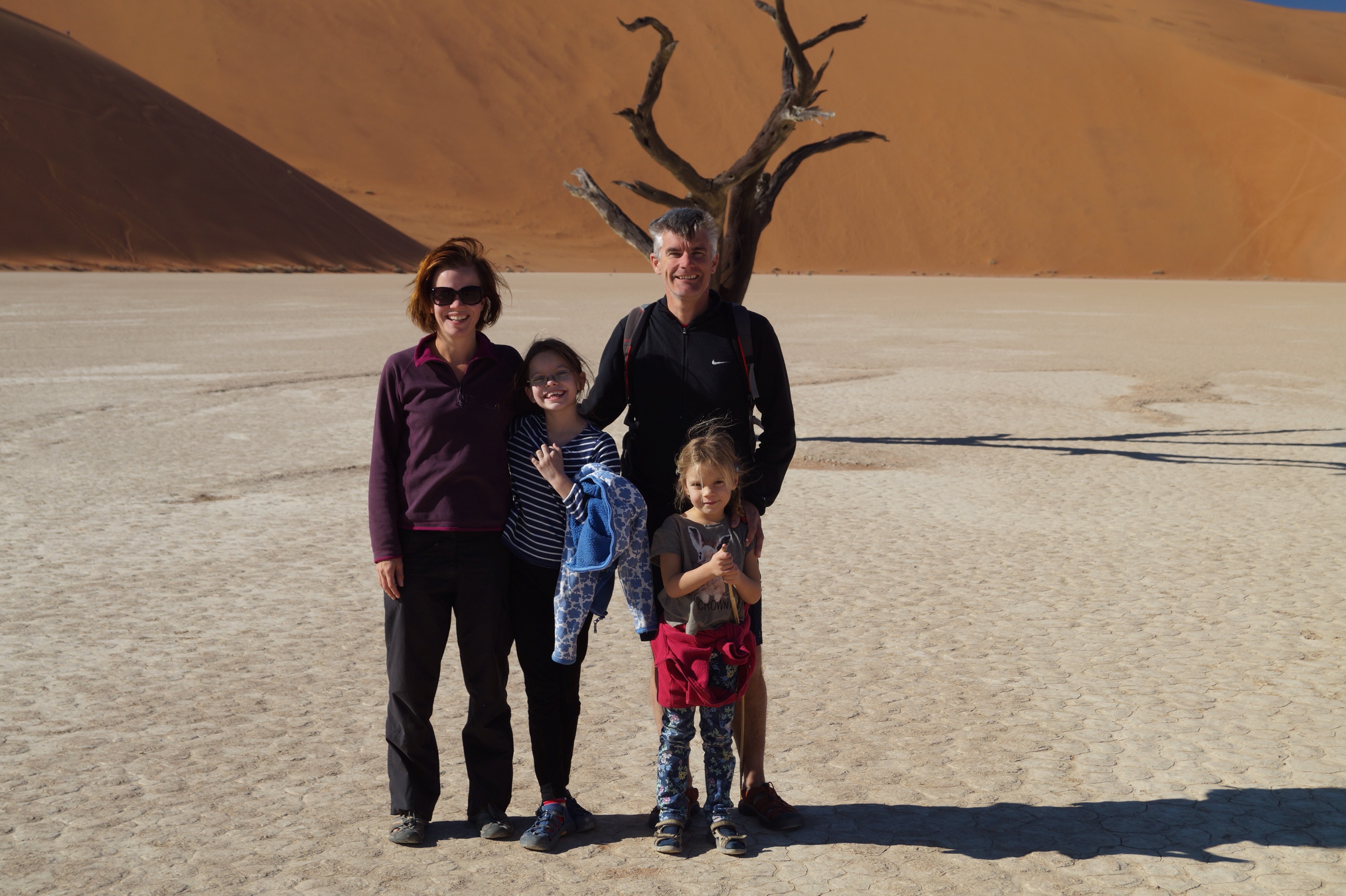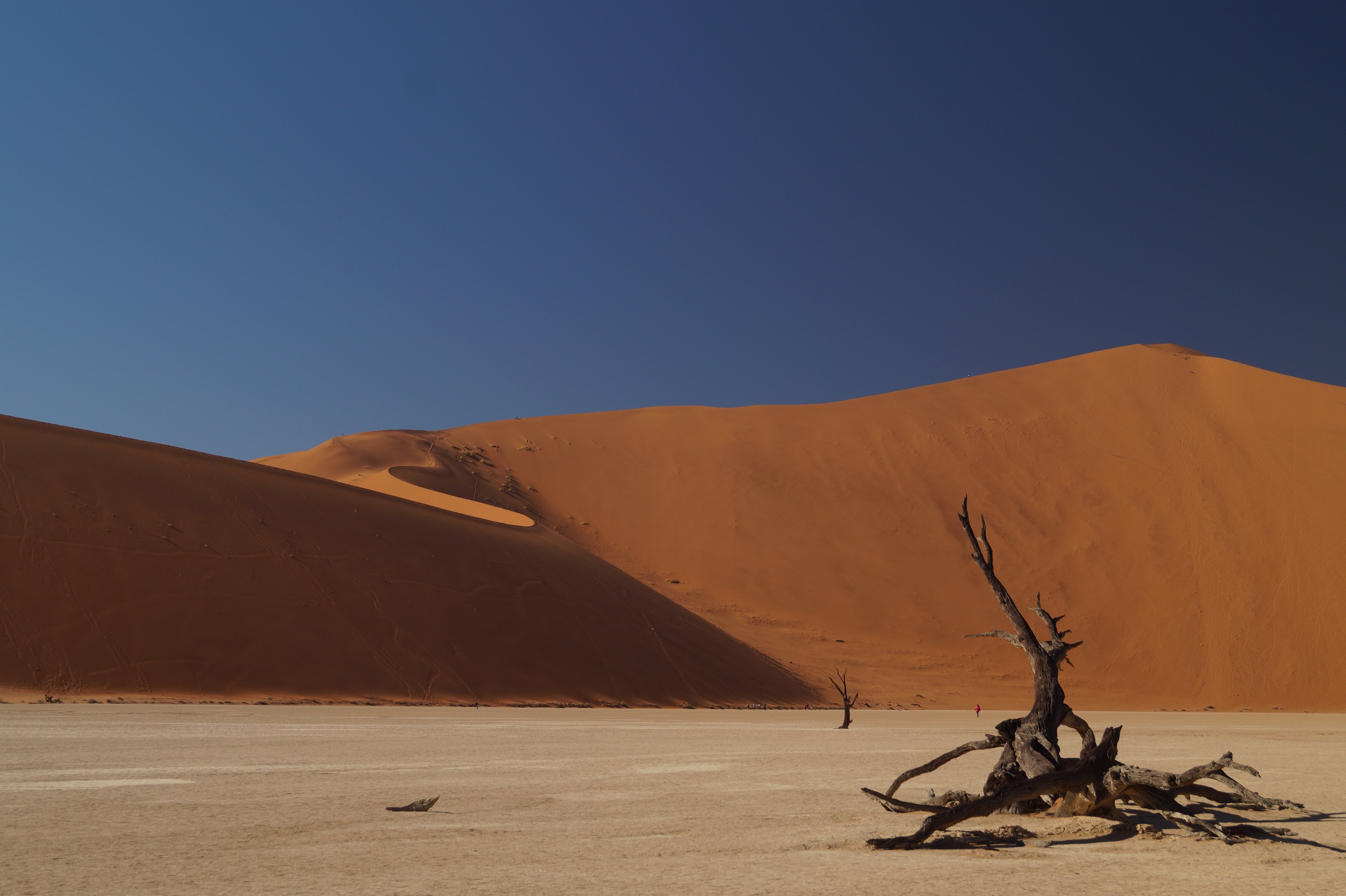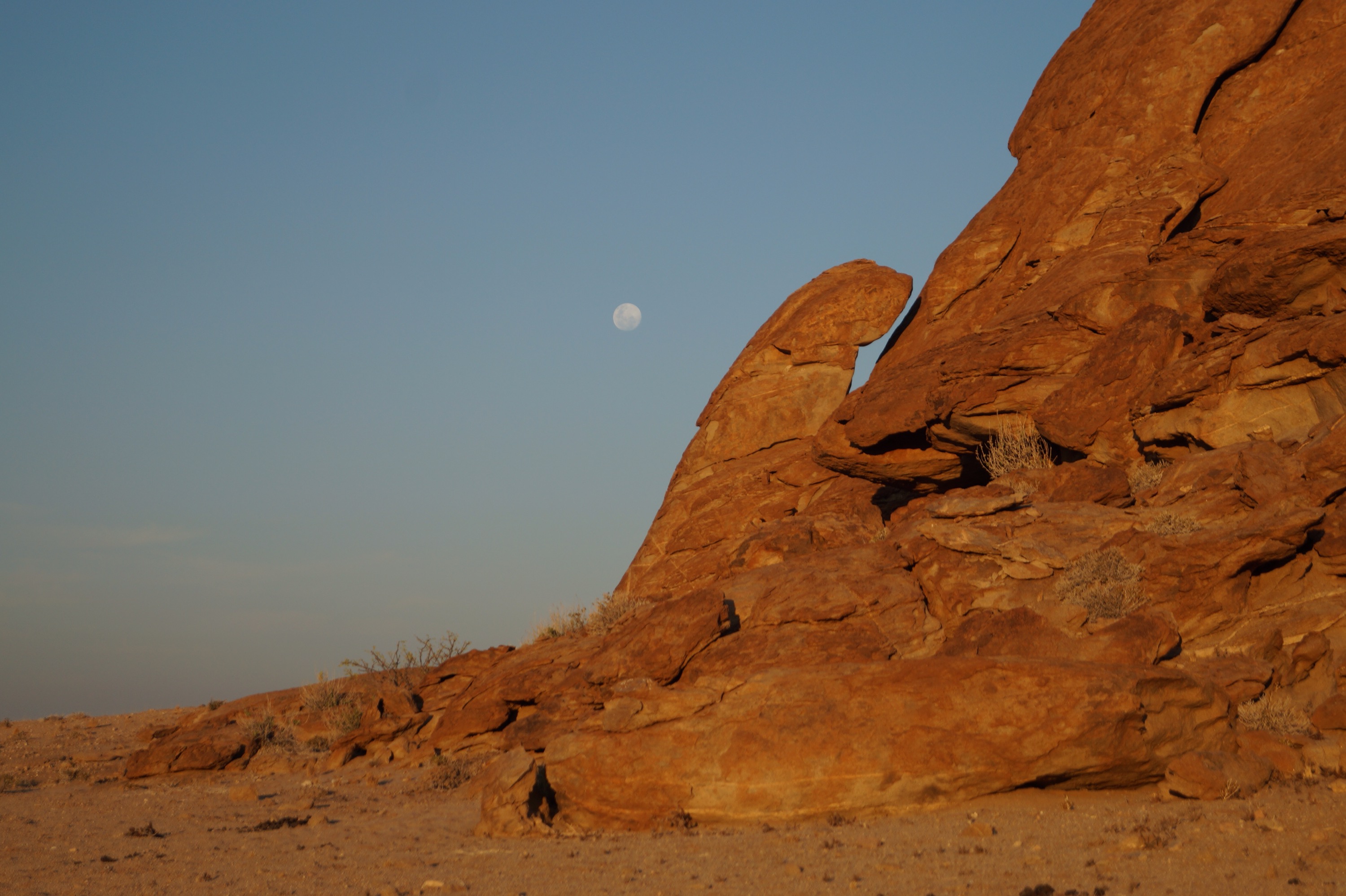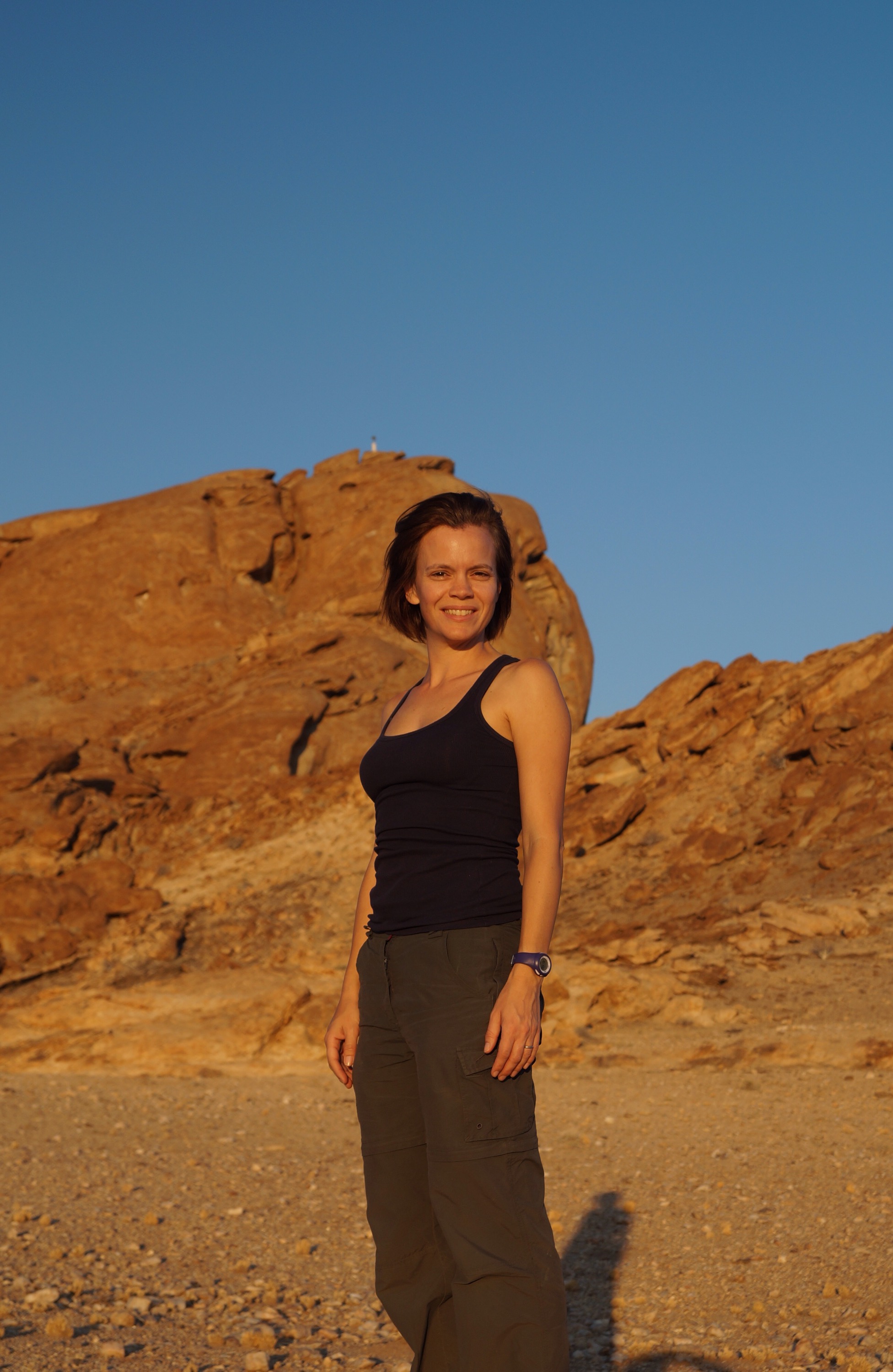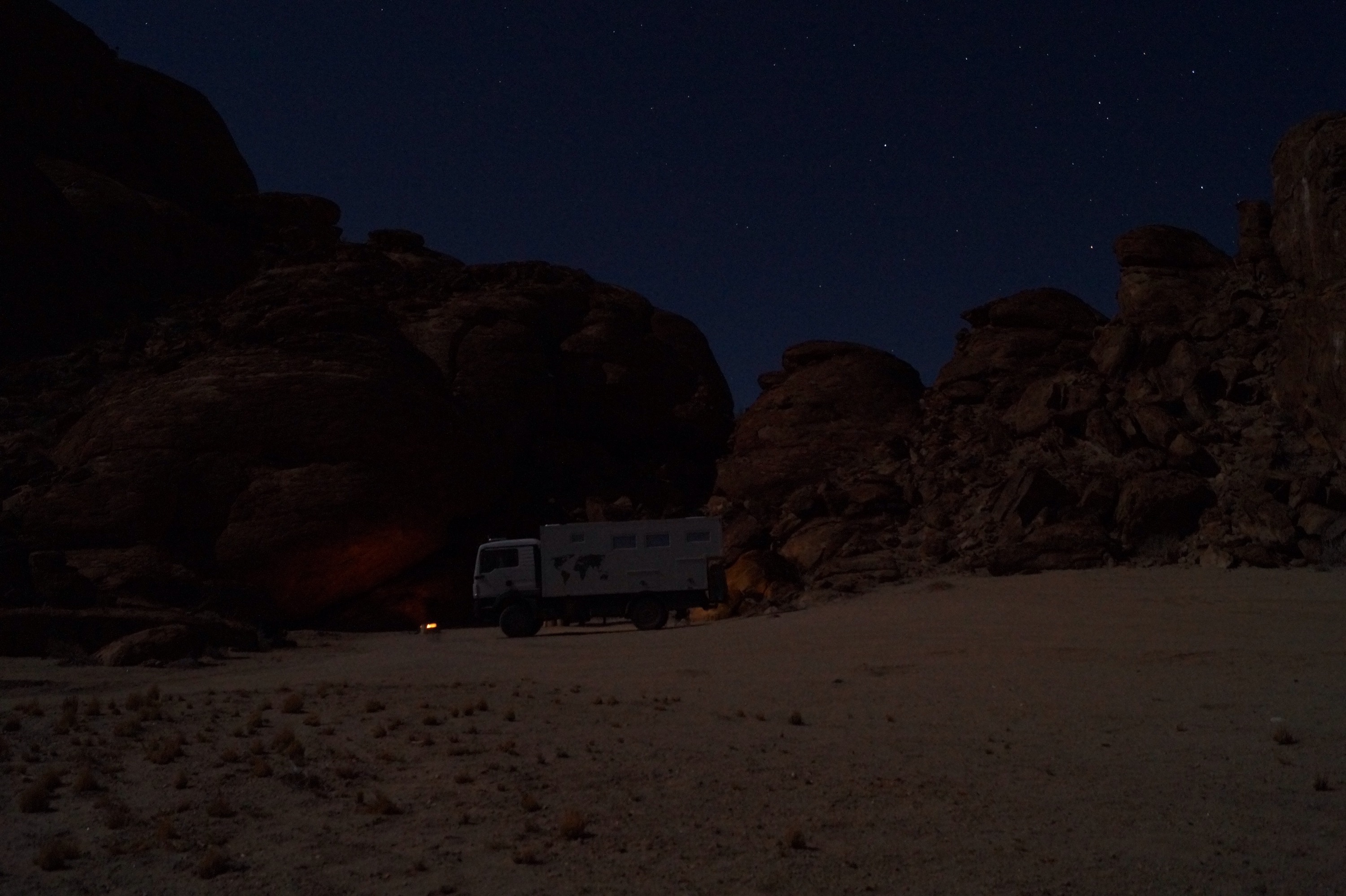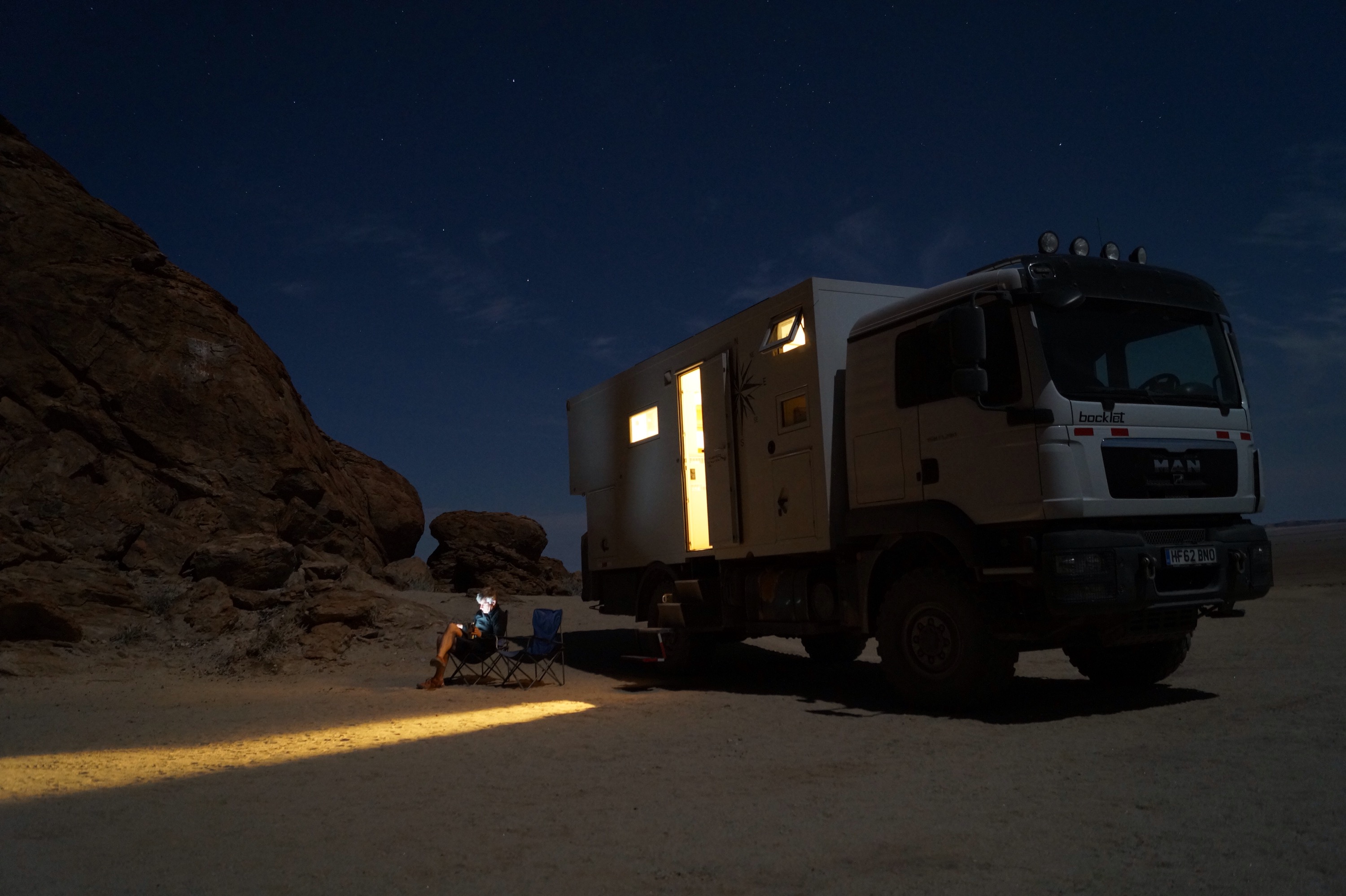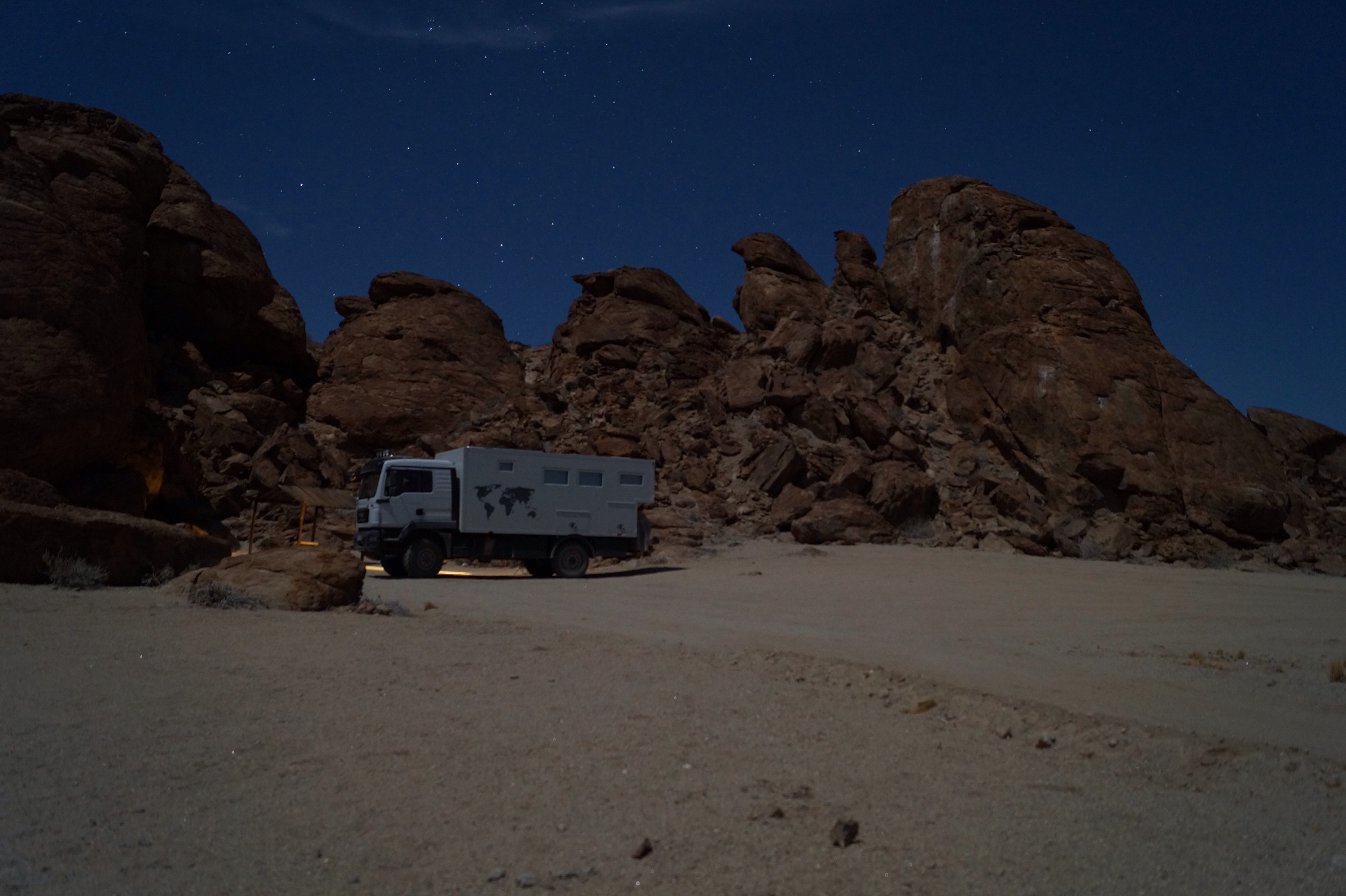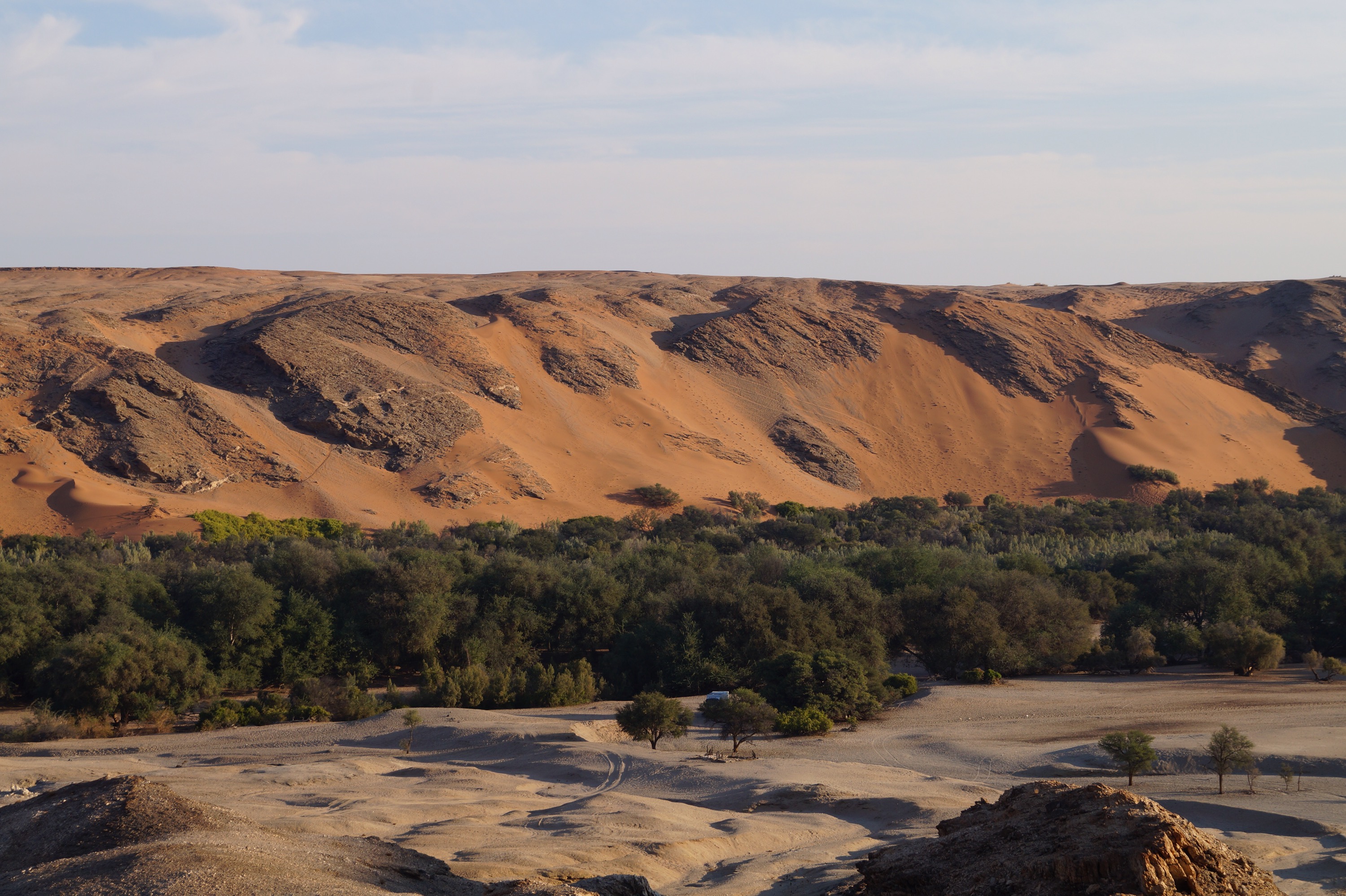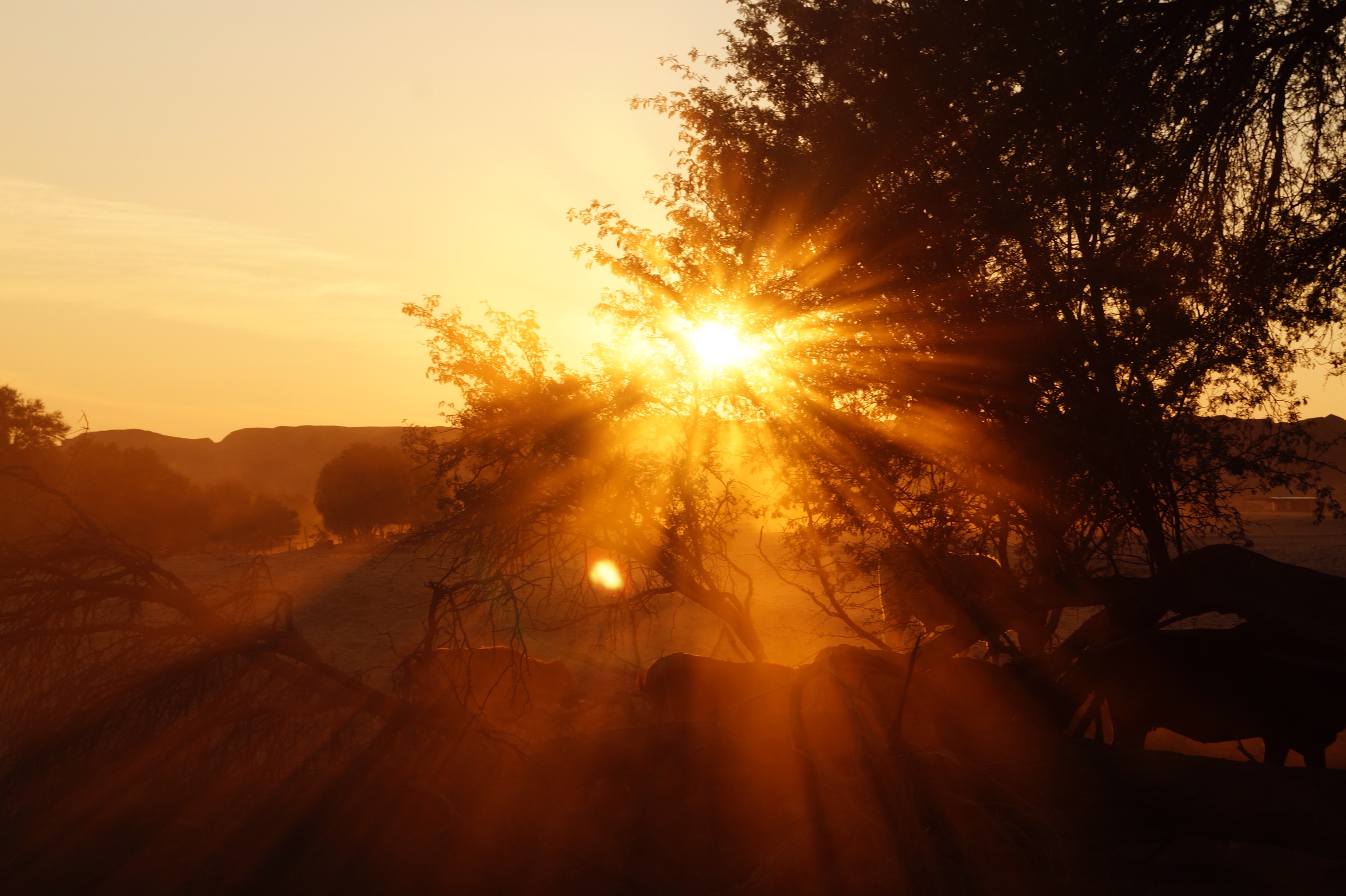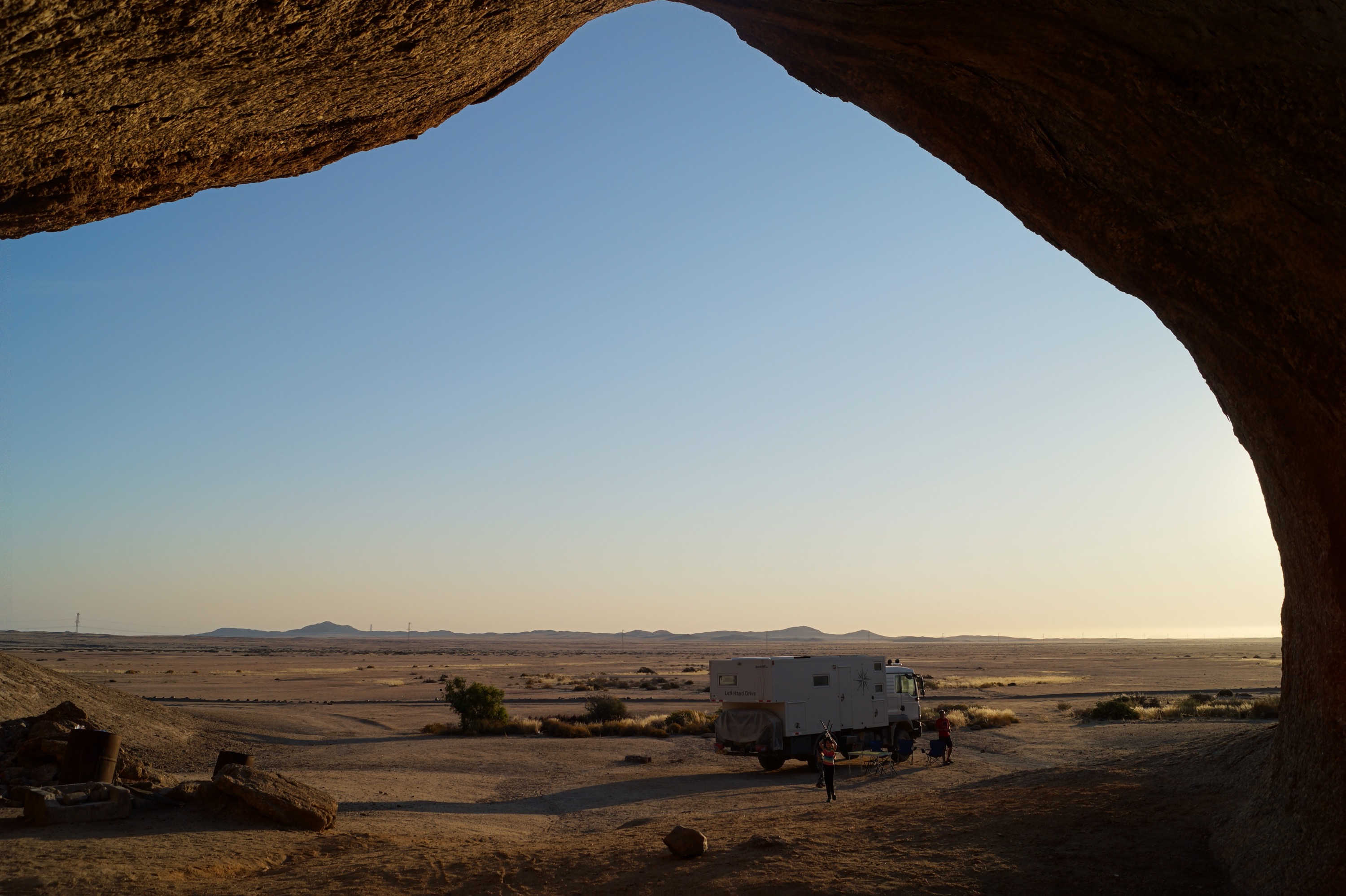With their bodies protected against the sun and insects by a covering of red ochre mixed with butter, red hair extensions, goat skin skirts and crowns the Himba ladies were an amazing sight. Like any group of close friends they chatter, gossiped, teased one another and answered our questions through John, our guide. As they got used to us they started to ask us questions too; about the children, their schooling and things like that. As I admired one of the tiny newborns, they asked me where our girls had been born and there was much chatter and comments when I told them the girls were born at home with my Mum. They said it was lovely to have families visiting them as usually it was just couples.
Lucy wanted to stay longer as she fell in love with the baby goats after one of the ladies asked if she would like to carry them from the kraal into the shade. Although she laughed and declined the ladies' suggestion that she could swap places with her daughter for a few weeks.
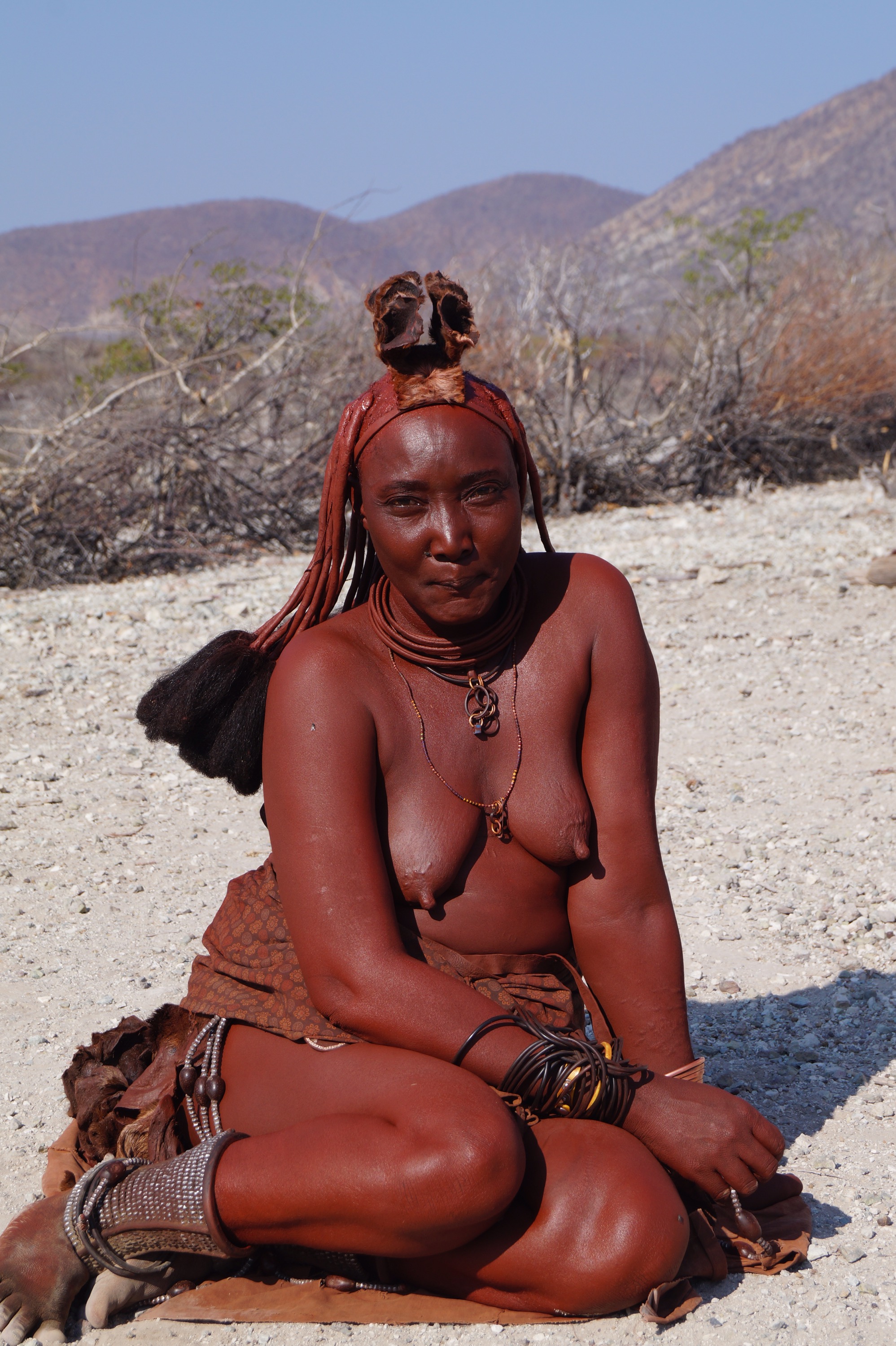
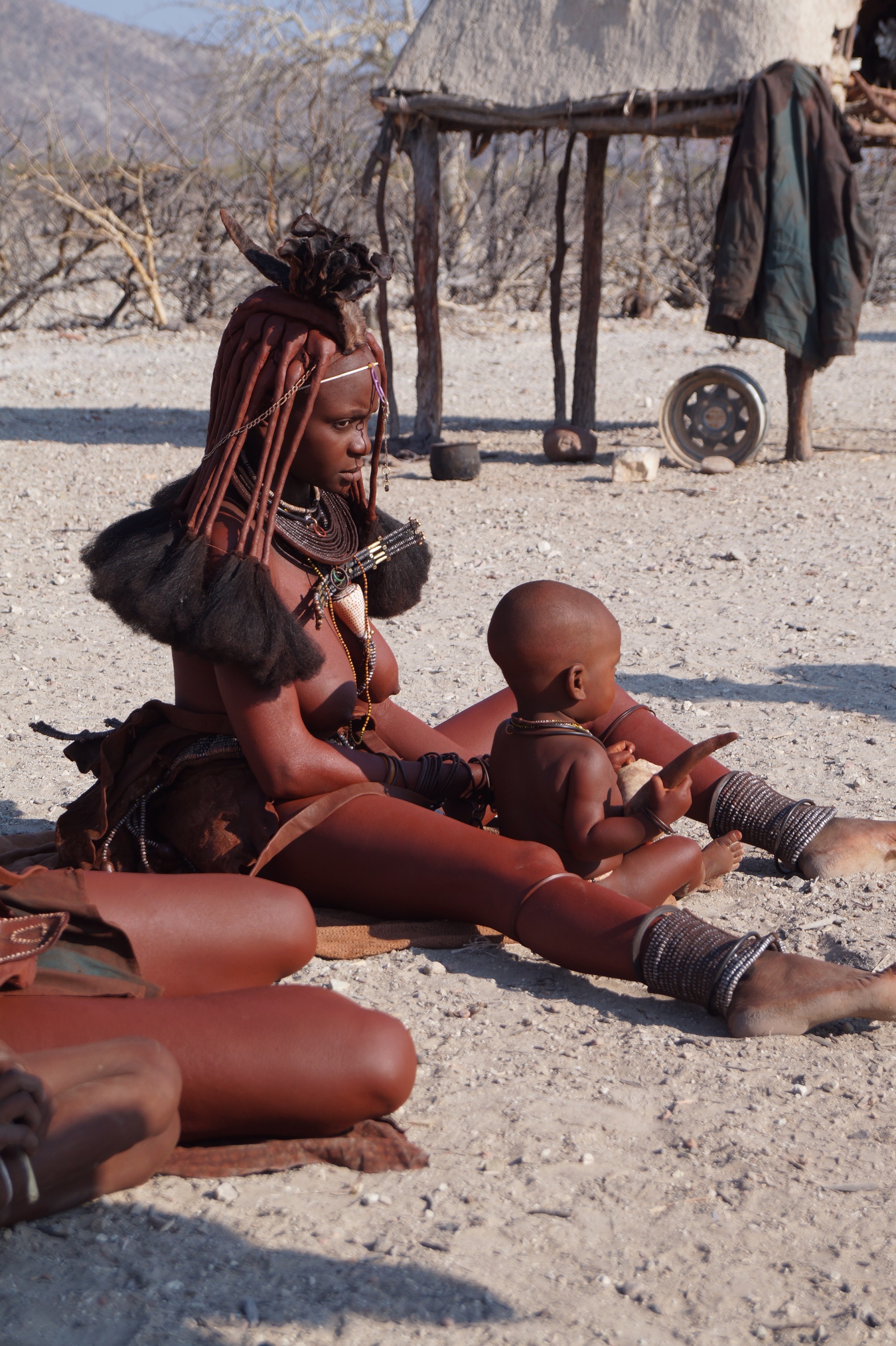
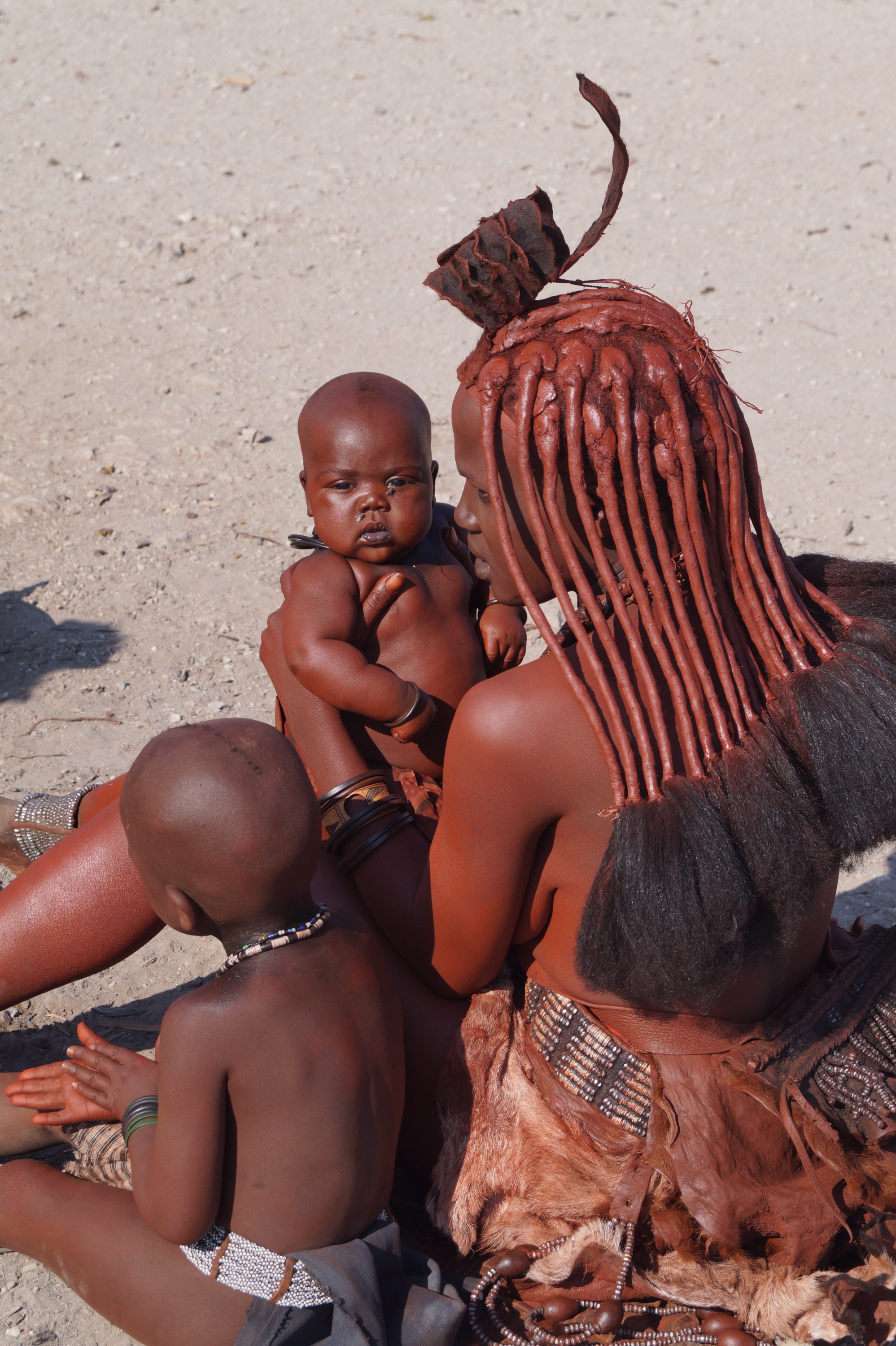

We had asked around at Epupu Falls campsite if there was a guide who could take us out to see a Himba village. We had seen them scattered around the area and wanted to know more about their culture. John, described himself as "Modern Himba" having given up traditional clothing, been to school, learnt English and now worked as a guide taking visitors out to see different villages. He explained that we would take a gift of maize meal, cooking oil, sugar and salt to be shared by everyone, to a local village. Once there he would ask permission of the Headman to ask if we could visit. The villages are just a collection of a few conical huts with a goat kraal in the centre. The Himba are polygamous, the village is just one family but the village we went to had two families. One man and most of the older children were away herding the family goats and cattle, it just just the Headman, ladies, toddlers and babies left in the village. After shaking hands, exchanging greetings which John had taught us, they showed us around. It's always slightly awkward meeting new people but after we declined John's suggestion to take photos straight away, everyone soon relaxed. It was fascinating to hear how the ladies used the smoke of aromatic bark to keep themselves sweet smelling, as water is a scarcity. That their amazing hairstyles are actually extensions with ochre rubbed around them and the hair tufts at the end are actually men's hair from when they cut it stitched on. They explained the meaning of the different adornments and hairstyles. Each of the wives have their own tidy hut with just space for a cow skin bed mat and a few belongings; and the husband shared his time between them. We bought some jewellery and baskets before we left, all with a slight red hue from the ochre to remind us of our visit.
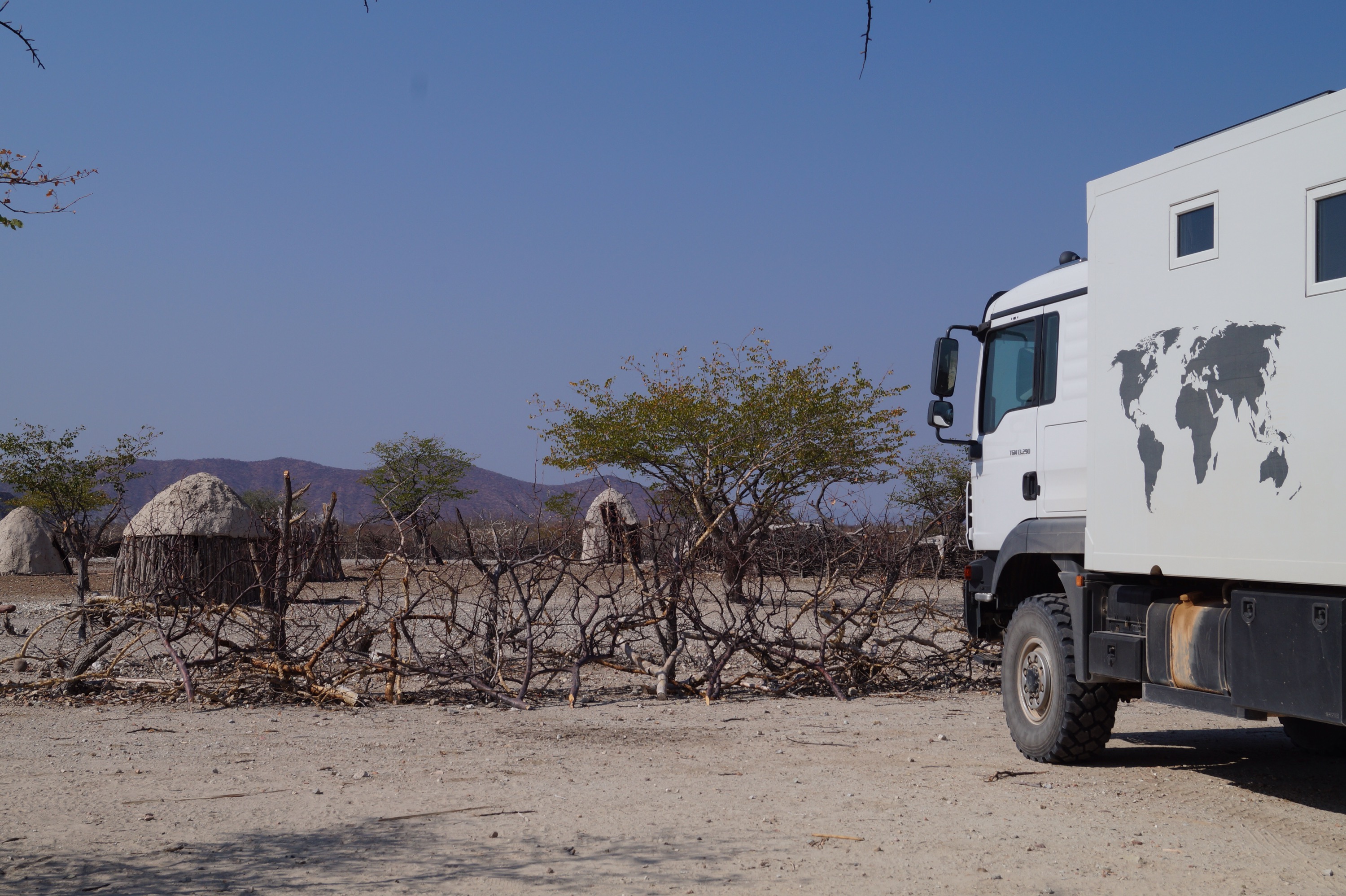

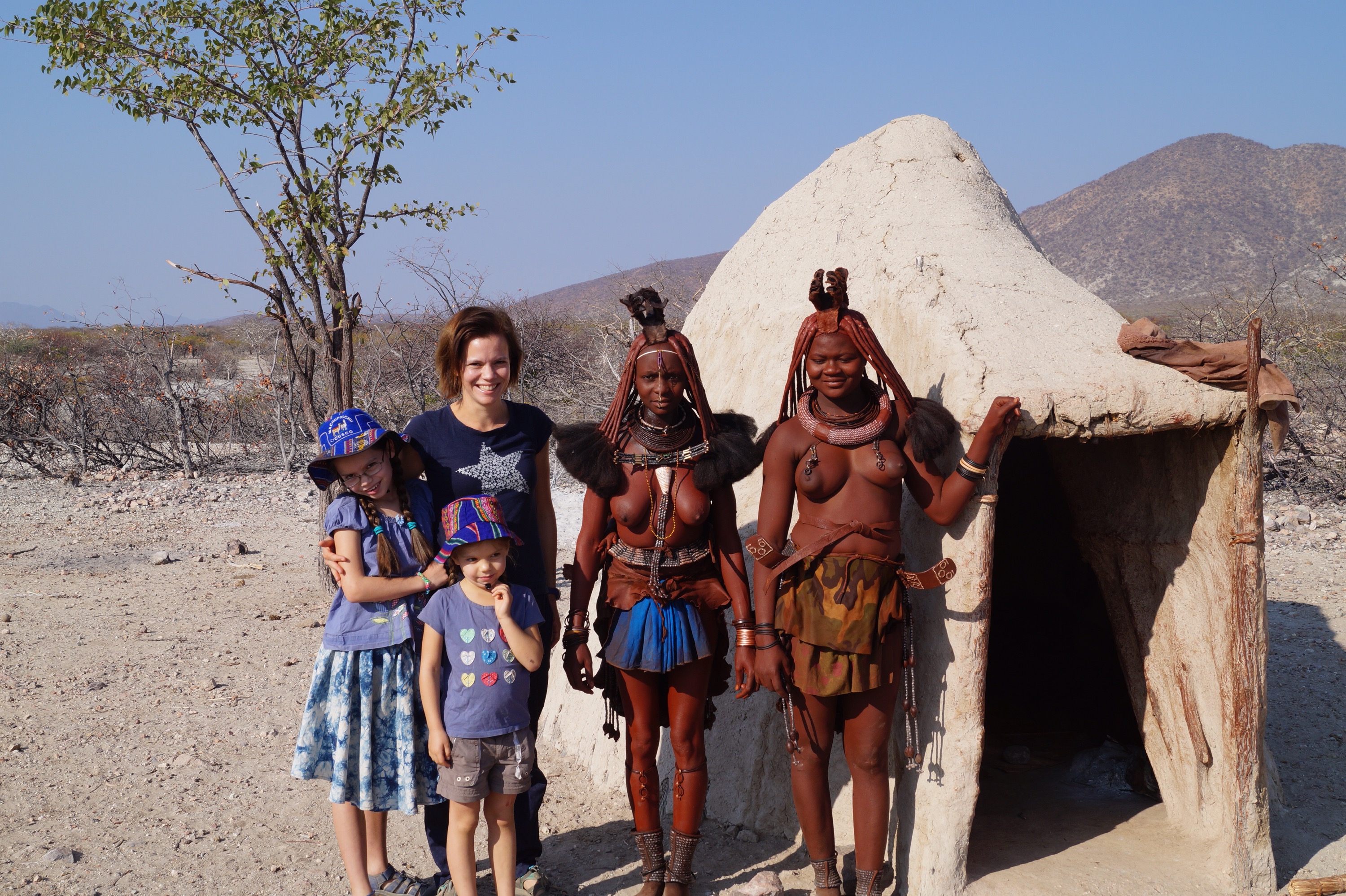
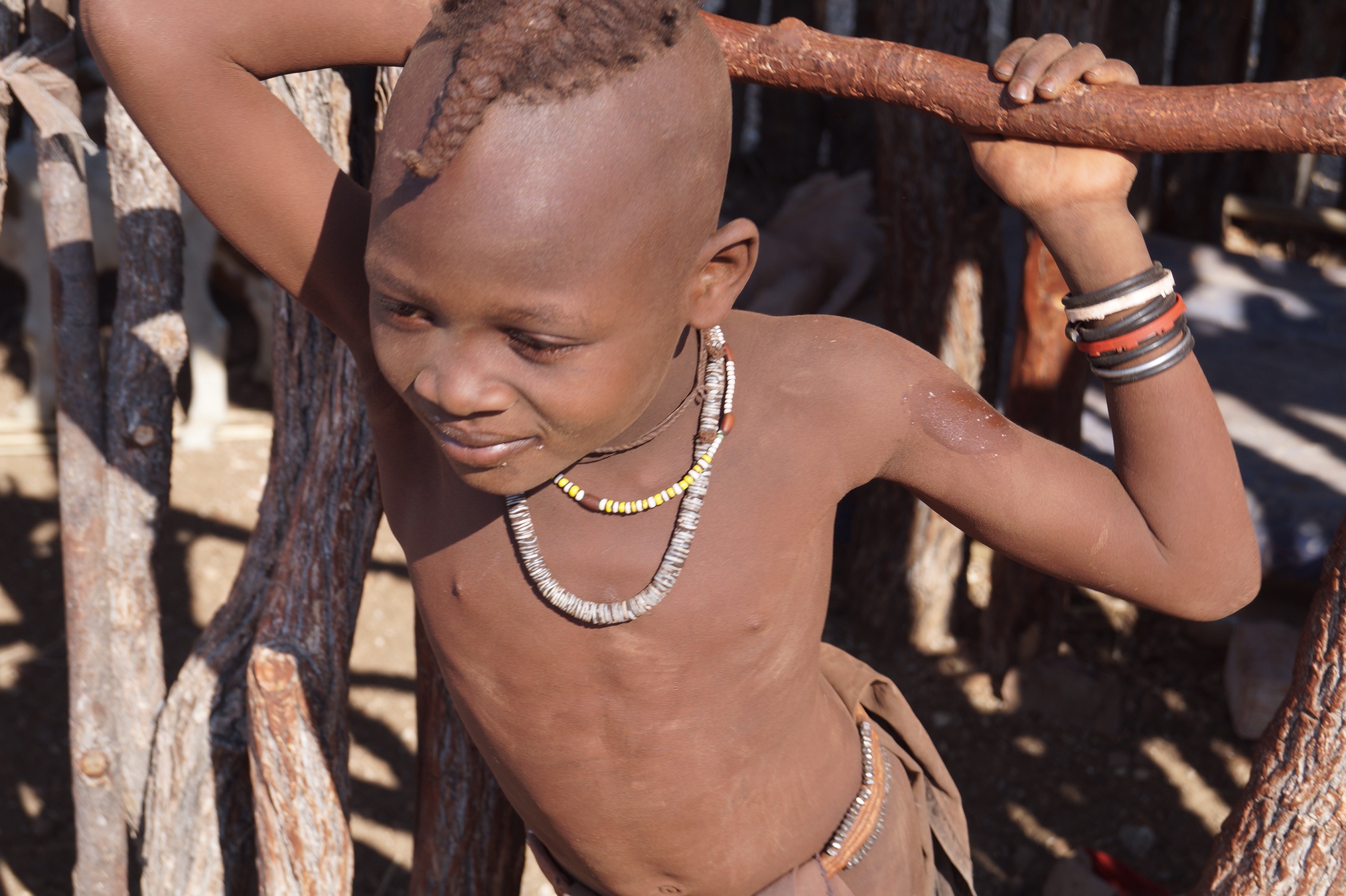
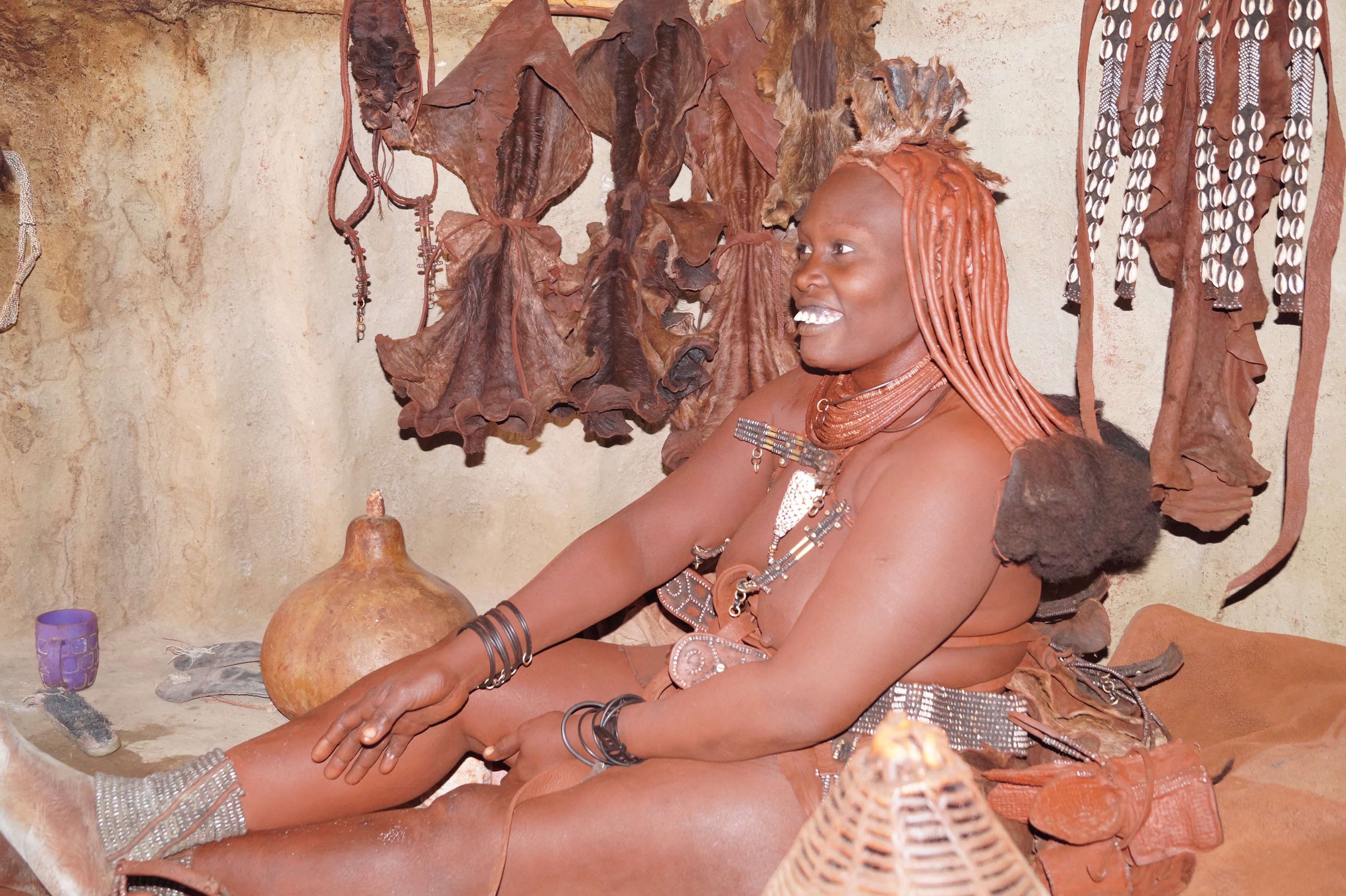
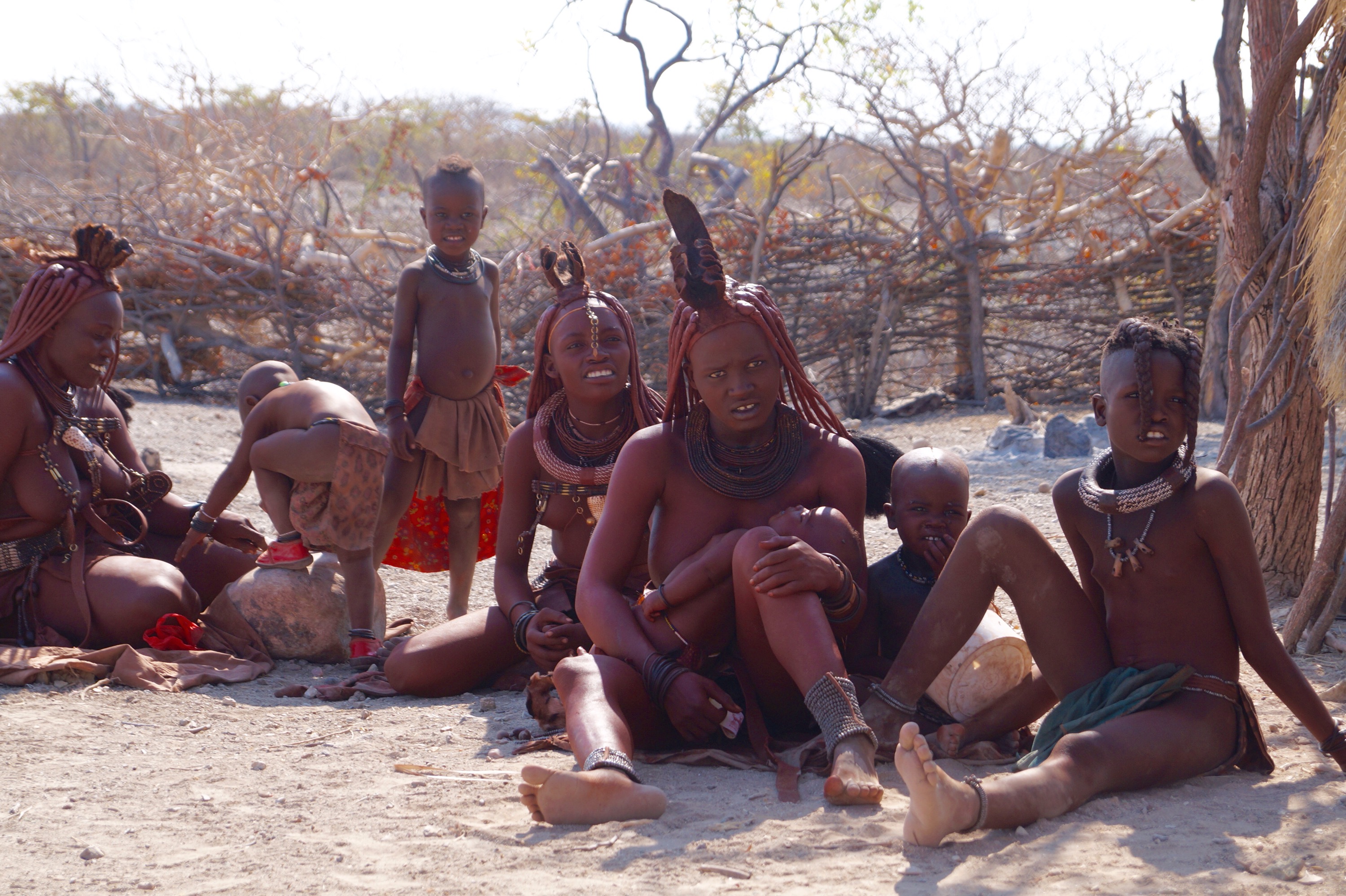
Kakoland in Northern Namibia next to the Angolan border is the traditional tribal lands of the Himba. Earlier in the week we had driven northwards from the rock art site at Twyfelfontein and stopped the night at a community campsite overlooking the Khowarib Gorge. Dotted about this part of rural Namibia are many community campsites, often set up with help from NGOs, run by local people as a way to generate income for community projects. We have stayed in several over the last few weeks, they've been all very pleasant and a good way to put money into the local economy.

In the dusty town of Opuwo we had been entranced by the variety and dress of the people coming into town. The most recognisable had been the Himba ladies. Their tall menfolk wore modern dress on the top half but kept their traditional clothes on the bottom with cloth gathered over a belt at the front; to make a double skirt effect and a different coloured cloth around their bottom. Herero ladies have distinctive Victorian style dresses made up of metres of petticoats crowding the pavements; their head scarf wraps with its unique cow horn shape. Another tribe's ladies had intricate beading in their hair and as jewellery; bare chests and coloured sarongs. It was fascinating. While Steve was stocking up for the next couple of weeks at the shops, the girls and I tried to do school in the back of the truck. We parked down a bank with the pavement at eye level, we kept on interrupting each other with another interesting sight out of the window. What the girls missed out in Maths that day they certainly made up for by what they saw outside. We spent 2 nights up on the hill at a lodge campsite overlooking the dry and dusty surrounding plains.
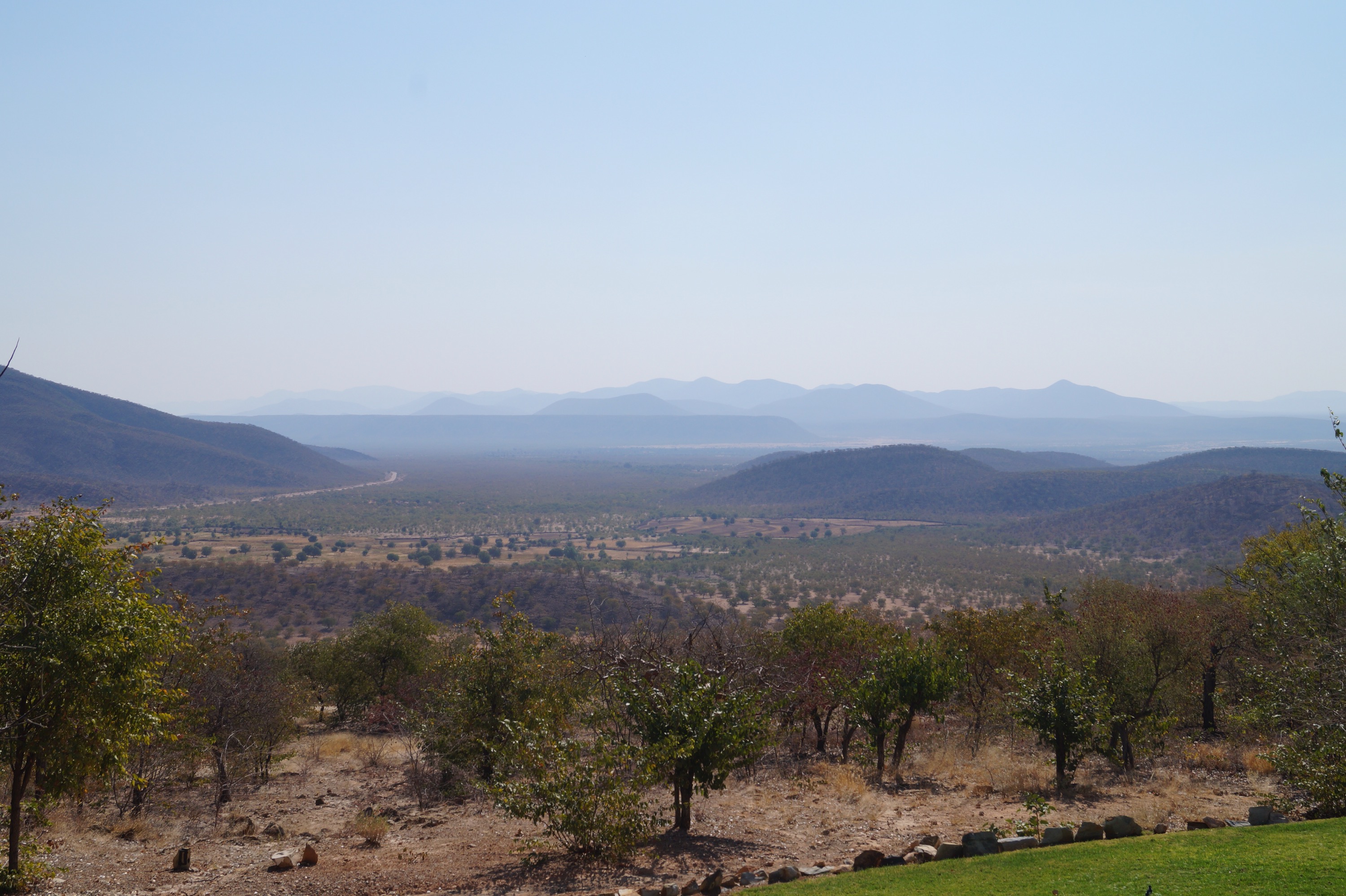
As we drove out of town and through the plains covered in low mopane trees, every so often we would see a track of a couple of tyre marks into the bush and a few cone shaped mud huts. Small herds of goats could be seen and the occasional cow but very few people. The Kunene River marks the border with Angola, the narrow strip of palm trees stood out in marked contrast with the brown, dusty surrounding hills. Epupa Falls are some of the prettiest waterfalls I've seen, the river splits into several channels and drops 60m or so into a swirling mass. Our campsite had a bar overlooking the top of the falls, as the sun set while Steve and I had a beer, the girls watched out for debris in the water. Watching any large palm leaves or logs, to see which way they would go in the waterfalls. It was like a giant version of their favourite "Pooh Sticks" game. The simple but picturesque campsite was perfectly situated under the palms shading us from the midday heat.
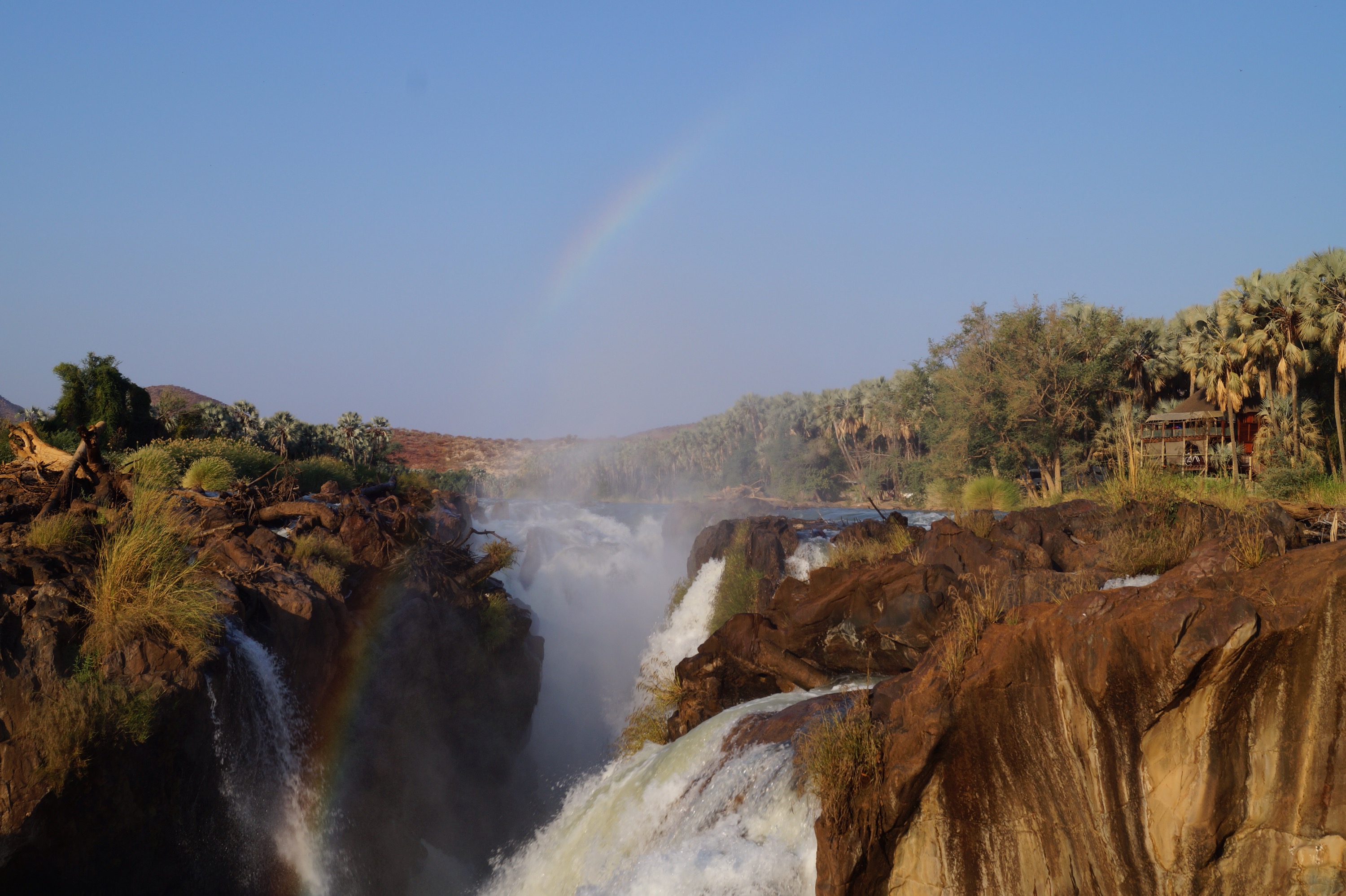
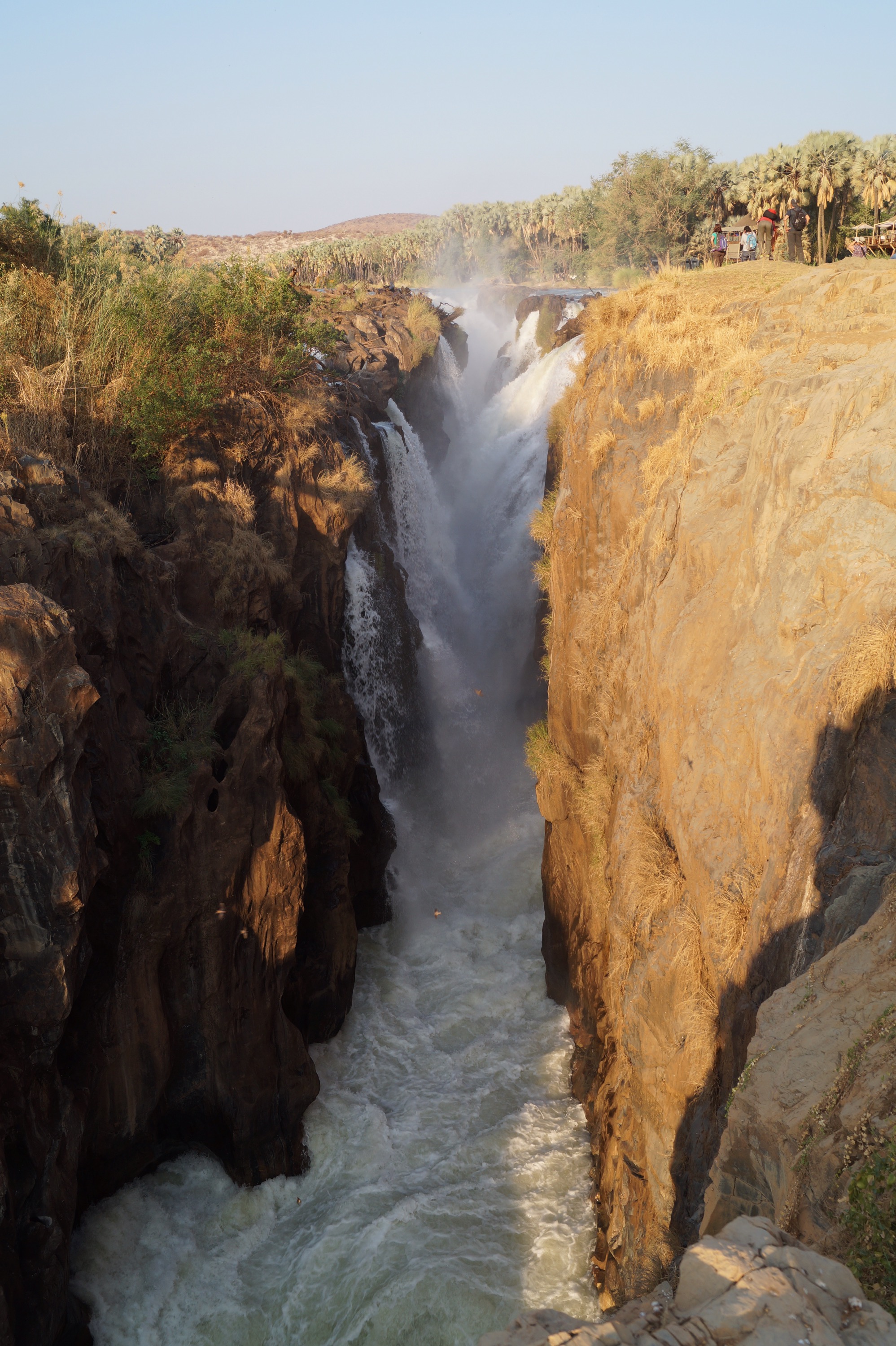
We had been repeatedly told that the road along the river was rough and with the trees would be a difficult road for a truck like ours so we backtracked 100kms to a road that would take us East along the river. At lunchtime we just pulled onto the side of the road as traffic was so rare. Two dots appeared on the horizon on the road and eventually turned into a couple of teenage boys walking to the nearby junction, to hopefully get a lift the 130kms or so to Opuwo where they went to school. Seeing us they immediately asked if we needed some help as we were parked on the side of the road, it was a humbling experience. We thanked them, gave them some water and shared some lunch before we parted in opposite directions. Further along at some roadworks we pulled in as a group of Himba ladies flagged us down. Thinking they wanted a lift on the very quiet road we stopped. I jumped down to get a old blanket from the lockers for them to sit on in the cab, as you can imagine the ochre mix is rather hard to wash out. They were all smiles, giggles and jokes. Eventually after lots of gesturing and the few words we spoke in common, it turned out they didn't want a lift but if we had any sweets that would be great, we didn't. That was absolutely fine with them, they just laughed, asked a few things we couldn't understand, joked some more and waved us goodbye.
Back at the river we had a couple of nights at a bird spotters lodge where we relaxed around the pool and enjoyed sundowners on the deck jutting out into the river. At Ruacana we had hoped to see their falls but the hydroelectric dam just upriver meant that the water level was too low. Instead all we saw was the cliff face. We found a pretty shaded community camp just below the falls for the night before heading off to spend some time in one of the highlights of Namibia.




 We had asked around at Epupu Falls campsite if there was a guide who could take us out to see a Himba village. We had seen them scattered around the area and wanted to know more about their culture. John, described himself as "Modern Himba" having given up traditional clothing, been to school, learnt English and now worked as a guide taking visitors out to see different villages. He explained that we would take a gift of maize meal, cooking oil, sugar and salt to be shared by everyone, to a local village. Once there he would ask permission of the Headman to ask if we could visit. The villages are just a collection of a few conical huts with a goat kraal in the centre. The Himba are polygamous, the village is just one family but the village we went to had two families. One man and most of the older children were away herding the family goats and cattle, it just just the Headman, ladies, toddlers and babies left in the village. After shaking hands, exchanging greetings which John had taught us, they showed us around. It's always slightly awkward meeting new people but after we declined John's suggestion to take photos straight away, everyone soon relaxed. It was fascinating to hear how the ladies used the smoke of aromatic bark to keep themselves sweet smelling, as water is a scarcity. That their amazing hairstyles are actually extensions with ochre rubbed around them and the hair tufts at the end are actually men's hair from when they cut it stitched on. They explained the meaning of the different adornments and hairstyles. Each of the wives have their own tidy hut with just space for a cow skin bed mat and a few belongings; and the husband shared his time between them. We bought some jewellery and baskets before we left, all with a slight red hue from the ochre to remind us of our visit.
We had asked around at Epupu Falls campsite if there was a guide who could take us out to see a Himba village. We had seen them scattered around the area and wanted to know more about their culture. John, described himself as "Modern Himba" having given up traditional clothing, been to school, learnt English and now worked as a guide taking visitors out to see different villages. He explained that we would take a gift of maize meal, cooking oil, sugar and salt to be shared by everyone, to a local village. Once there he would ask permission of the Headman to ask if we could visit. The villages are just a collection of a few conical huts with a goat kraal in the centre. The Himba are polygamous, the village is just one family but the village we went to had two families. One man and most of the older children were away herding the family goats and cattle, it just just the Headman, ladies, toddlers and babies left in the village. After shaking hands, exchanging greetings which John had taught us, they showed us around. It's always slightly awkward meeting new people but after we declined John's suggestion to take photos straight away, everyone soon relaxed. It was fascinating to hear how the ladies used the smoke of aromatic bark to keep themselves sweet smelling, as water is a scarcity. That their amazing hairstyles are actually extensions with ochre rubbed around them and the hair tufts at the end are actually men's hair from when they cut it stitched on. They explained the meaning of the different adornments and hairstyles. Each of the wives have their own tidy hut with just space for a cow skin bed mat and a few belongings; and the husband shared his time between them. We bought some jewellery and baskets before we left, all with a slight red hue from the ochre to remind us of our visit.





 Kakoland in Northern Namibia next to the Angolan border is the traditional tribal lands of the Himba. Earlier in the week we had driven northwards from the rock art site at Twyfelfontein and stopped the night at a community campsite overlooking the Khowarib Gorge. Dotted about this part of rural Namibia are many community campsites, often set up with help from NGOs, run by local people as a way to generate income for community projects. We have stayed in several over the last few weeks, they've been all very pleasant and a good way to put money into the local economy.
Kakoland in Northern Namibia next to the Angolan border is the traditional tribal lands of the Himba. Earlier in the week we had driven northwards from the rock art site at Twyfelfontein and stopped the night at a community campsite overlooking the Khowarib Gorge. Dotted about this part of rural Namibia are many community campsites, often set up with help from NGOs, run by local people as a way to generate income for community projects. We have stayed in several over the last few weeks, they've been all very pleasant and a good way to put money into the local economy.
 In the dusty town of Opuwo we had been entranced by the variety and dress of the people coming into town. The most recognisable had been the Himba ladies. Their tall menfolk wore modern dress on the top half but kept their traditional clothes on the bottom with cloth gathered over a belt at the front; to make a double skirt effect and a different coloured cloth around their bottom. Herero ladies have distinctive Victorian style dresses made up of metres of petticoats crowding the pavements; their head scarf wraps with its unique cow horn shape. Another tribe's ladies had intricate beading in their hair and as jewellery; bare chests and coloured sarongs. It was fascinating. While Steve was stocking up for the next couple of weeks at the shops, the girls and I tried to do school in the back of the truck. We parked down a bank with the pavement at eye level, we kept on interrupting each other with another interesting sight out of the window. What the girls missed out in Maths that day they certainly made up for by what they saw outside. We spent 2 nights up on the hill at a lodge campsite overlooking the dry and dusty surrounding plains.
In the dusty town of Opuwo we had been entranced by the variety and dress of the people coming into town. The most recognisable had been the Himba ladies. Their tall menfolk wore modern dress on the top half but kept their traditional clothes on the bottom with cloth gathered over a belt at the front; to make a double skirt effect and a different coloured cloth around their bottom. Herero ladies have distinctive Victorian style dresses made up of metres of petticoats crowding the pavements; their head scarf wraps with its unique cow horn shape. Another tribe's ladies had intricate beading in their hair and as jewellery; bare chests and coloured sarongs. It was fascinating. While Steve was stocking up for the next couple of weeks at the shops, the girls and I tried to do school in the back of the truck. We parked down a bank with the pavement at eye level, we kept on interrupting each other with another interesting sight out of the window. What the girls missed out in Maths that day they certainly made up for by what they saw outside. We spent 2 nights up on the hill at a lodge campsite overlooking the dry and dusty surrounding plains.
 As we drove out of town and through the plains covered in low mopane trees, every so often we would see a track of a couple of tyre marks into the bush and a few cone shaped mud huts. Small herds of goats could be seen and the occasional cow but very few people. The Kunene River marks the border with Angola, the narrow strip of palm trees stood out in marked contrast with the brown, dusty surrounding hills. Epupa Falls are some of the prettiest waterfalls I've seen, the river splits into several channels and drops 60m or so into a swirling mass. Our campsite had a bar overlooking the top of the falls, as the sun set while Steve and I had a beer, the girls watched out for debris in the water. Watching any large palm leaves or logs, to see which way they would go in the waterfalls. It was like a giant version of their favourite "Pooh Sticks" game. The simple but picturesque campsite was perfectly situated under the palms shading us from the midday heat.
As we drove out of town and through the plains covered in low mopane trees, every so often we would see a track of a couple of tyre marks into the bush and a few cone shaped mud huts. Small herds of goats could be seen and the occasional cow but very few people. The Kunene River marks the border with Angola, the narrow strip of palm trees stood out in marked contrast with the brown, dusty surrounding hills. Epupa Falls are some of the prettiest waterfalls I've seen, the river splits into several channels and drops 60m or so into a swirling mass. Our campsite had a bar overlooking the top of the falls, as the sun set while Steve and I had a beer, the girls watched out for debris in the water. Watching any large palm leaves or logs, to see which way they would go in the waterfalls. It was like a giant version of their favourite "Pooh Sticks" game. The simple but picturesque campsite was perfectly situated under the palms shading us from the midday heat. 
 We had been repeatedly told that the road along the river was rough and with the trees would be a difficult road for a truck like ours so we backtracked 100kms to a road that would take us East along the river. At lunchtime we just pulled onto the side of the road as traffic was so rare. Two dots appeared on the horizon on the road and eventually turned into a couple of teenage boys walking to the nearby junction, to hopefully get a lift the 130kms or so to Opuwo where they went to school. Seeing us they immediately asked if we needed some help as we were parked on the side of the road, it was a humbling experience. We thanked them, gave them some water and shared some lunch before we parted in opposite directions. Further along at some roadworks we pulled in as a group of Himba ladies flagged us down. Thinking they wanted a lift on the very quiet road we stopped. I jumped down to get a old blanket from the lockers for them to sit on in the cab, as you can imagine the ochre mix is rather hard to wash out. They were all smiles, giggles and jokes. Eventually after lots of gesturing and the few words we spoke in common, it turned out they didn't want a lift but if we had any sweets that would be great, we didn't. That was absolutely fine with them, they just laughed, asked a few things we couldn't understand, joked some more and waved us goodbye.
Back at the river we had a couple of nights at a bird spotters lodge where we relaxed around the pool and enjoyed sundowners on the deck jutting out into the river. At Ruacana we had hoped to see their falls but the hydroelectric dam just upriver meant that the water level was too low. Instead all we saw was the cliff face. We found a pretty shaded community camp just below the falls for the night before heading off to spend some time in one of the highlights of Namibia.
We had been repeatedly told that the road along the river was rough and with the trees would be a difficult road for a truck like ours so we backtracked 100kms to a road that would take us East along the river. At lunchtime we just pulled onto the side of the road as traffic was so rare. Two dots appeared on the horizon on the road and eventually turned into a couple of teenage boys walking to the nearby junction, to hopefully get a lift the 130kms or so to Opuwo where they went to school. Seeing us they immediately asked if we needed some help as we were parked on the side of the road, it was a humbling experience. We thanked them, gave them some water and shared some lunch before we parted in opposite directions. Further along at some roadworks we pulled in as a group of Himba ladies flagged us down. Thinking they wanted a lift on the very quiet road we stopped. I jumped down to get a old blanket from the lockers for them to sit on in the cab, as you can imagine the ochre mix is rather hard to wash out. They were all smiles, giggles and jokes. Eventually after lots of gesturing and the few words we spoke in common, it turned out they didn't want a lift but if we had any sweets that would be great, we didn't. That was absolutely fine with them, they just laughed, asked a few things we couldn't understand, joked some more and waved us goodbye.
Back at the river we had a couple of nights at a bird spotters lodge where we relaxed around the pool and enjoyed sundowners on the deck jutting out into the river. At Ruacana we had hoped to see their falls but the hydroelectric dam just upriver meant that the water level was too low. Instead all we saw was the cliff face. We found a pretty shaded community camp just below the falls for the night before heading off to spend some time in one of the highlights of Namibia.


